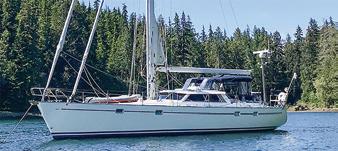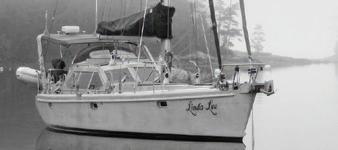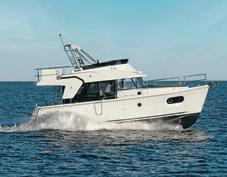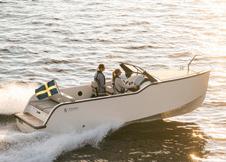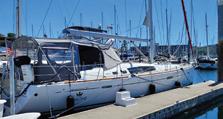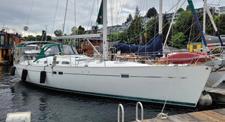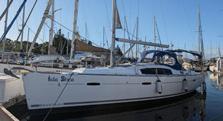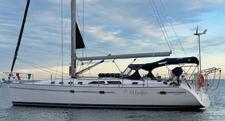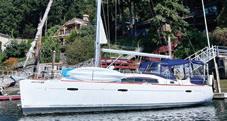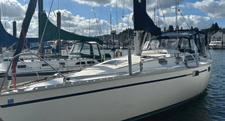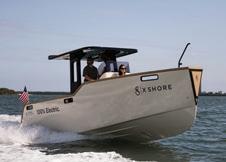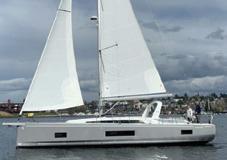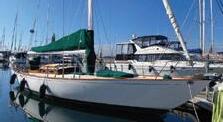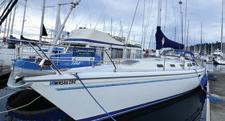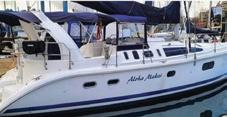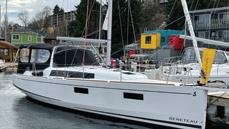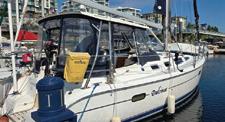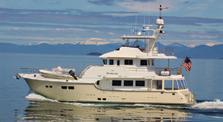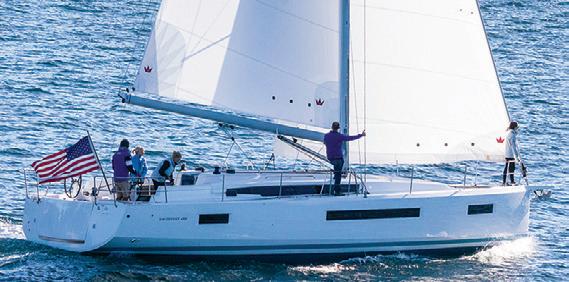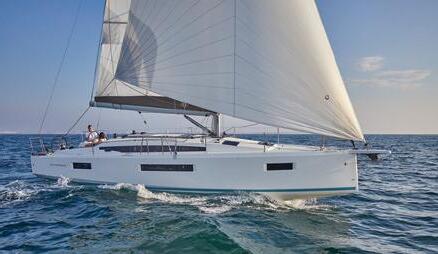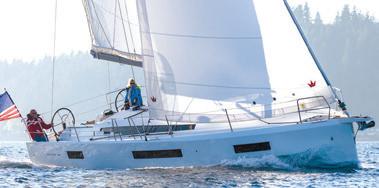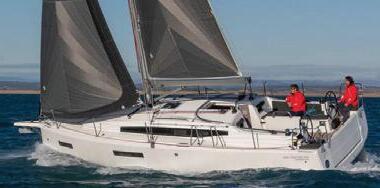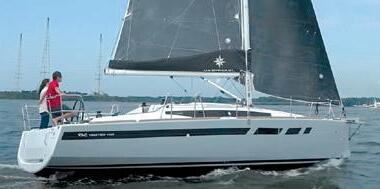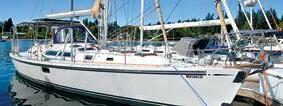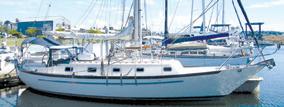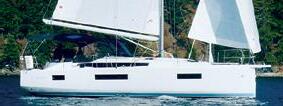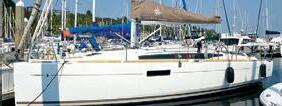




























FEATURED MODELS:
Keep Your Battery Charged Through Fall and Winter! November 16 through December 2
ProMariner ProSport & ProTournament Series:
As the boating season winds down, it’s crucial to ensure your batteries stay in top shape during the colder months. At Fisheries Supply, we’re offering unbeatable deals on high-performance on-board battery chargers from ProMariner and Mastervolt, so you can maintain power and protect your investment all year long.
• Waterproof and corrosion-resistant design
• Built for marine environments with advanced multi-stage charging
• Digital LED display for easy monitoring
• Fully automatic and energy-efficient


FEATURED
• Available in a variety of models to meet your boat’s needs Mastervolt Inverter Chargers:
ProMariner ProSport & ProTournament Series:
• Waterproof and corrosion-resistant design
• Built for marine environments with advanced multi-stage charging
• Digital LED display for easy monitoring
• Fully automatic and energy-efficient
• Available in a variety of models to meet your boat’s needs

• Combines inverter and charger functions for complete onboard power
• High-efficiency charging to maximize battery life
• Lightweight and compact design
• Suitable for all types of batteries, including lithium-ion
• Silent operation for enhanced onboard comfort
Mastervolt Inverter Chargers:
• Combines inverter and charger functions for complete onboard power
• High-efficiency charging to maximize battery life
• Lightweight and compact design
• Suitable for all types of batteries, including lithium-ion
• Silent operation for enhanced onboard comfort
Top
Andy Cross

The
Solvig Sayre
An
A while back, I found myself in a casual conversation with other cruisers when someone commented, “We always anchor, we never go to marinas.”
“Ok, that’s fine,” I remember thinking at the time.
Conversations like these always cover a wide scope of topics and I’ll generally give my input when it’s appropriate. But the declaration seemed to come with an air of superiority, with the belief that by anchoring exclusively, they were somehow better cruisers than those who choose to use marinas when they want or need to. The comment was only given a passing nod by the folks who were chatting, and I later thought of it as kind of perplexing.
First off, who really cares how much time you stay at anchor versus in a marina? And secondly, to me, marina stays seem to be just as much of a key component to the cruising lifestyle as anchoring. They go hand in hand to round out the experience.
Throughout my years of cruising in various regions and countries, especially in the Pacific Northwest, our family has always enjoyed a mix of anchoring in far-flung places and also visiting marinas in quaint towns or larger cities. It’s the contrast of delving into both worlds that provides us with a unique perspective on the natural and urban surroundings, and the people who live and work there. Marinas are also a great place to meet fellow boaters that you might not while at anchor, which I love.
While taking three months to circumnavigate Vancouver Island, our family anchored the vast majority of the time. But when marinas popped up along our cruising route, we were more than happy to stop at some out-of-the-way places like Echo Bay, Sullivan Bay Marina, Coal Harbour, Westview Marina, Tofino Harbour, and others. When I look back on it, these stops peppered among the many secluded and magical anchorages we visited were just as memorable—sometimes more so. Larger cities like Vancouver, Nanaimo, and Victoria were also significantly special parts of our voyage that summer because they were so vastly different from the remote anchorages of British Columbia.
I was reminded of this while reading Deborah Bach’s column “Destination Tacoma” on page 22. Deborah and her husband, Marty, along with their boat kitty, have sailed many miles up and down the Inside Passage aboard their Passport 40, including a summer foray into Southeast Alaska. And being close friends, I know their cruising style meshes with my own.
In her column, Deborah paints a wonderful picture of how cruising local and stopping at marinas can be part of the cruising lifestyle. They hadn’t been to Tacoma on their boat in many years (nor have I) and it was fascinating to follow along as she and Marty explored the vibrant waterfront, charming neighborhoods, and distinctive pubs and restaurants of a city that has changed significantly since their last visit. It made me wish I was sharing the marina space and city alongside them.
There are no designated anchorages in Tacoma, and that fact alone made me realize that you’d miss out on the experience by skipping it if you “never go to marinas.” One of the immensely special parts of cruising the Salish Sea, though, is that there are plenty of beautiful anchorages to drop your hook (see my feature on page 32) and equally as many marinas where you can stretch your legs in a new-to-you town or city.
However you choose to enjoy your time on the water, it’s great that there’s something for all of us.


Volume XLIV, Number 4, November 2024 (206) 789-7350 info@48north.com | www.48north.com
Publisher Northwest Maritime
Managing Editor Joe Cline joe@48north.com
Editor Andy Cross andy@48north.com
Associate Editor Deborah Bach
Designer Rainier Powers rainier@48north.com
Advertising Sales Ryan Carson ryan@48north.com
Classifieds classads48@48north.com
Photographer Jan Anderson
48° North is published as a project of Northwest Maritime in Port Townsend, WA – a 501(c)3 non-profit organization whose mission is to engage and educate people of all generations in traditional and contemporary maritime life, in a spirit of adventure and discovery.
Northwest Maritime Center: 431 Water St, Port Townsend, WA 98368 (360) 385-3628
48° North encourages letters, photographs, manuscripts, burgees, and bribes. Emailed manuscripts and high quality digital images are best!
We are not responsible for unsolicited materials. Articles express the author’s thoughts and may not reflect the opinions of the magazine. Reprinting in whole or part is expressly forbidden except by permission from the editor.
SUBSCRIPTION OPTIONS FOR 2024! $39/Year For The Magazine
$100/Year For Premium (perks!)
www.48north.com/subscribe for details.
Prices vary for international or first class.
Proud members:













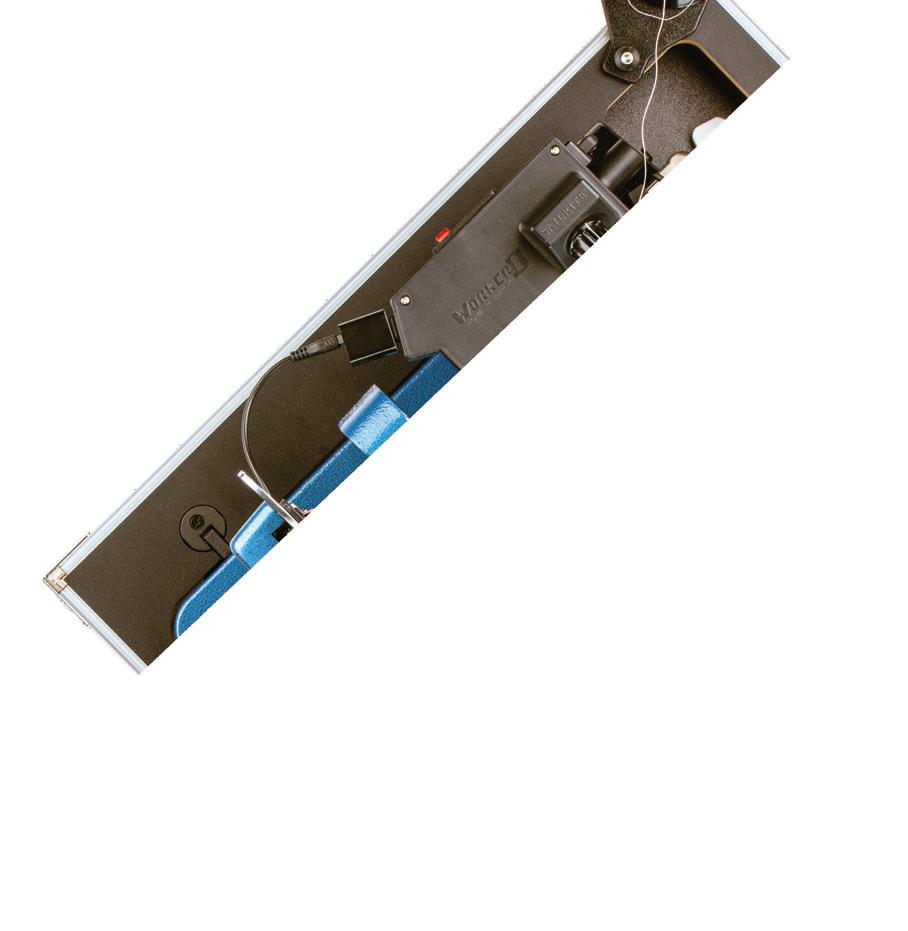






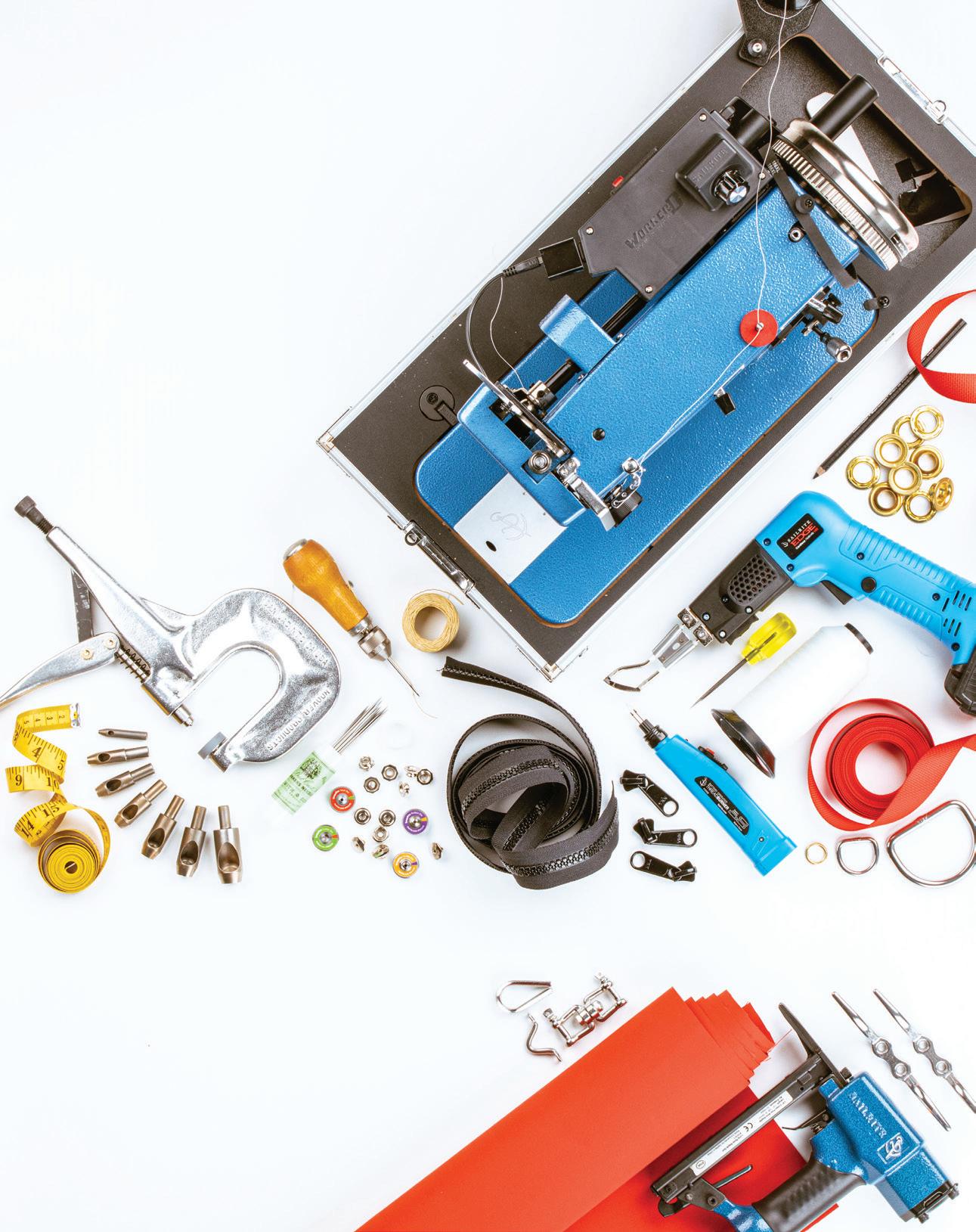



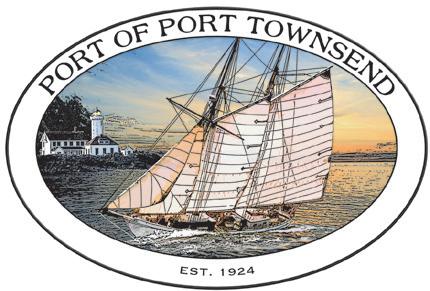
48° North has been published by the nonprofit Northwest Maritime since 2018. We are continually amazed and inspired by the important work of our colleagues and organization, and dedicate this page to sharing more about these activities with you.
WA360: THE PUGET SOUND SHOWDOWN IS BACK IN 2025
2021. With the world at a standstill, toilet paper running out, and the Canadian border ever-so-politely slammed closed, our beloved Race to Alaska (R2AK) was benched for a second year in a row. But two years was too long for bad ideas to go unexplored, and so with minimal deliberation, a new race emerged: WA360—a 360(ish) mile loop through Washington’s waterways. Fiftysix intrepid teams hit the water and, once complete, it immediately vanished as R2AK remembered who it was. Now, the time is ripe, and WA360 is set to blow the roof back off in June 2025.
Upon the announcement of the move to a biennial race schedule (you read that right, race fans, R2AK is now an every-other-year type party) the several grumbles and half-dozen laments were drowned out with a fresh round of excitement. Dozens of R2AK alums are secretly plotting a 2025 program, and fresh blood—many reveling in the rule allowing engines to remain aboard, albeit untouched—are daring themselves to poke the bear. Some are aiming for the 1180 Award: The oversized medallion earned by completing the three Northwest Maritime adventure races—R2AK, SEVENTY48, and WA360. Others seek to follow in the footsteps of fan favorites like Jim Heumann who, before his famous 2024 R2AK pedal-fest, was amongst the finishers of the 2021 WA360.
WA360 is a giant, Puget Sound-shaped puzzle. Starting in Port Townsend, four waypoints demand that racers explore the fjords of western Washington in a counter-clockwise fashion from Olympia in the south, to Point Roberts in the north, before arriving back at Port Townsend’s finish line. The race classes are simple:


The Wind Division for those with sails, and The Muscle Division for those without. And if you think you know who to bet on, spend some time with the tracker replay of 2021, where it is plain to see that fast sailboats are not guaranteed to win this thing. Kayak duo Team Bend Racing and the pedal-powered Team Boogie Barge led the entire fleet for the first twoand-a-half days, only succumbing to an overtake by Team Big Broderna after that team was able to claw its way past the doldrums and into a fresh breeze after the Bellingham Bay checkpoint.
In the coming year, prepare for WA360 to shake off its prepubescent reliance on the slam-bang energy of its older sibling R2AK; this race is its own beast, and invites the people and communities of Puget Sound to get in the ring and spar, homecoming-game-rivalry-style, with their neighbors. Forget watching pedaldriven Santa Cruz 27s vanishing in the northern reaches and prepare for this thing to happen in your own front yard.
Jesse Wiegel - Race Boss, Northwest Maritime

EVENTS & CLASSES
THINKING OF RACING IN WA360? Choose your power: Wind or Muscle. Applications to race open November 15 at WA360.org
ELECTRONIC NAVIGATION & VHF –ONLINE
Nov 6-7 | 6:30 PM - 8 PM
$90 non-member, $81 member
HANDS-ON SHIP SIMULATOR TOURS
Nov 9 | 10:30 AM - 2:30 PM
Free and first come first serve All ages welcome
RADAR, COLLISION AVOIDANCE, & NIGHT NAVIGATION – ONLINE
Nov 12-13 | 6:30 PM - 8 PM
$90 non-member, $81 member
TIDES & CURRENTS IN THE SALISH SEA – ONLINE
Nov 19-20 | 6:30 PM - 8 PM
$90 non-member, $81 member
For more details, visit: » www.nwmaritime.org/events
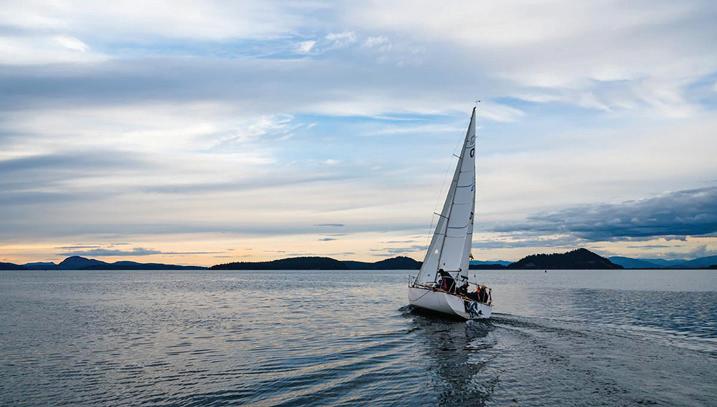



The Seattle Boat Show cruises into town on Friday, January 31 and sails on through Saturday, February 8, 2025. It’s the largest show on the West Coast with two locations: indoors at Lumen Field Event Center—with hundreds of vessels of all kinds and three acres of accessories and services—and on the water at the Port of Seattle’s Bell Harbor Marina. A free shuttle runs continuously between both locations.
The show has always been known for its extensive line up of boating, fishing, and Boat Show U seminars. For 2025, the show is back to having three stages for the in-person fishing and boating seminars. This means there will be well over one hundred seminars to choose from, covering boating

POULSBO FUEL DOCK AND GUEST MOORAGE CLOSED FOR CONSTRUCTION
Attention cruisers! If you’re planning a trip to Poulsbo, be advised that the fuel dock, and E and F docks are currently closed for construction until approximately midDecember. Additionally, winter moorage will NOT be offered during this time, the tidal grid is closed, and the pump-outs on the fuel dock will not be available.
The parking lot at the top of E dock ramp will be closed to vehicles during construction. However, the bathhouse and mailbox will remain open and accessible by foot. Limited dinghy parking will be available on the far side of the boat ramp dock. Do not tie your dinghy up anywhere in permanent moorage. Four-hour stays are available on the breakwater for $10. If you have questions, contact the harbormaster at » harbormaster@portofpoulsbo.com
safety, fishing techniques, navigation, cruising, and the latest innovations, technology, and more. The seminar schedule will be released on November 1.
More in-depth boating courses for a fee are available through Boat Show University — either in the form of a single day Boat Show University course, or a 9-Day BSU Package. The singleday courses include a 2-hour course, single day admission to the show, and a complimentary beer or wine at the BSU Experts reception held every evening from 4 - 6 p.m. in the new Seahawks Tunnel Club. The team at Waggoner Cruising Guide will feature an expert guest every evening.
The 9-Day Seminar Package comes with it all: admission to all show days, every Boat Show University course, a complimentary beer or wine each evening at the BSU Experts Reception, and online access to the recorded BSU courses.
Fun features include wine and beer nights, Women’s Day (Mon. Feb 3), Twofer Tuesday Tickets, Military Appreciation Day on Wednesday, and a special Kids Aqua Zone full of family-friendly activities.
TICKETS:
• Tickets are on sale now
• Adult Ticket - $20.00
• 9-Day Pass - $40.00
• Kids 17 & Under - Free
• Boat Show University Single Day - $49
• Boat Show University 9-day Package - $175
• (Boat Show University tickets available online only)
» www.SeattleBoatShow.com
PLATYPUS MARINE WELCOMES NIGEL BARRON TO THE TEAM
Platypus Marine recently announced the addition of Nigel Barron to their dynamic team. With over 20 years of experience in the marine industry, Nigel brings a wealth of expertise and a passion for sailing and boats that will be invaluable to Platypus and their clients.
Based in Seattle, Nigel aims to enhance Platypus Marine’s presence in the greater Puget Sound area, ensuring that they remain responsive to customer needs, and continue to grow their business. In his new role at Platypus Marine, Nigel will collaborate closely with their sales
team to promote and expand services in new builds, repairs, and refits. Nigel began his career as a sailboat rigger and steadily advanced to project management, accumulating extensive experience in Seattle. He holds a 100-ton USCG license and has captained a custom racing sailboat, successfully completing nine voyages between Hawaii and the mainland. This professional journey not only highlights his technical skills but also underscores his dedication to the maritime world. A lifelong sailor, Nigel was born in England and moved to the U.S. in 1987.
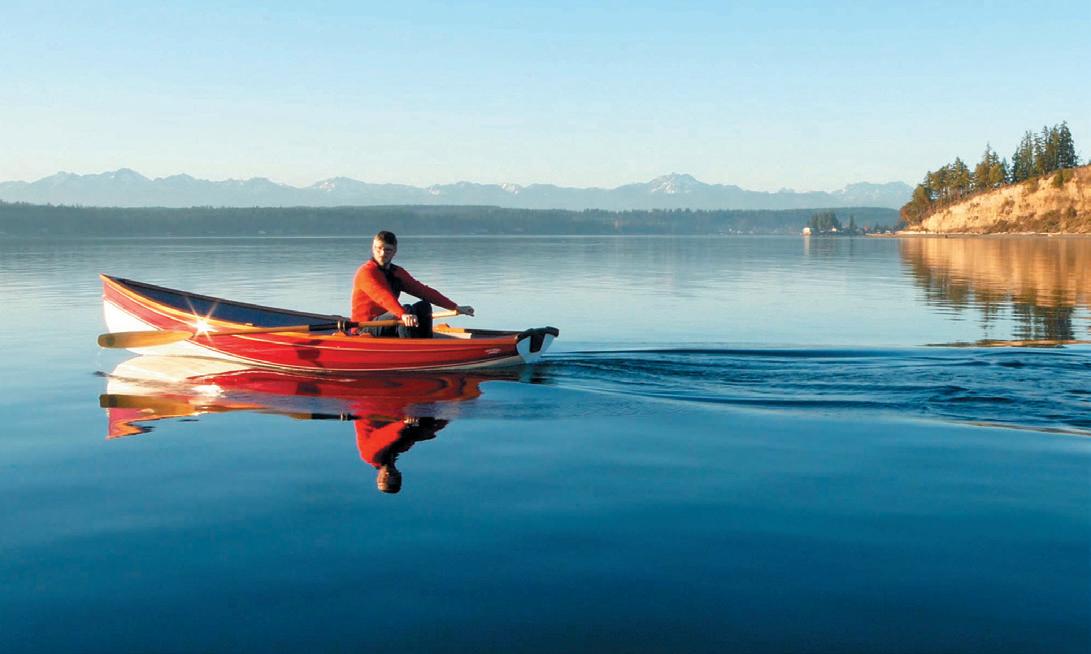


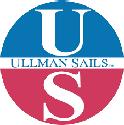
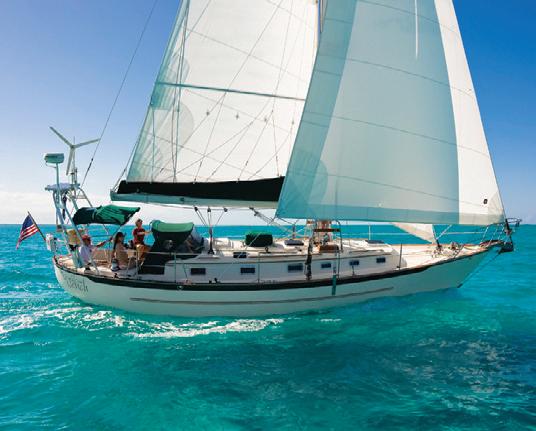





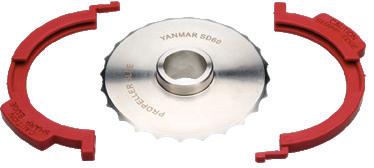

Yanmar Marine International has introduced its first rope cutter, an easy-to-install safety feature designed solely for sailboats equipped with the YANMAR SD60 sail drive and fixed two or three blade propellers. Suitable for both monohulls and catamarans, the SD60 Rope Cutter is ideal for a range of cruising sailors, charter boat operators, and sailing schools to enhance safety and reduce maintenance costs and downtime. The circular saw blade mounts directly onto the shaft behind the propeller, and turns with the shaft to effectively stop ropes, weeds, plastic, and fishing lines from jamming between the cutlass and the propeller, removing the hazard almost instantly before bearing or other mechanical failures can occur. The rope cutter is a cost-effective and efficient tool to decrease damage and minimize the inconvenience of debris catching on any sailboat equipped with the SD60, which is compatible with the 3JH5E, 3JH40, 4JH5E, 4JH45, 4JH4-TE, 4JH57, and 4JH80 engines.
Price: $310 » www.yanmar.com/marine.

Musto has recently launched their new BR1 ‘Winter Collection’ to add to their best-selling BR1 series, making the range a year-round set of apparel for the cruising community in cooler climes. Perfect for sailors in the Pacific Northwest, the collection includes the BR1 Primaloft® Channel Sailing Jacket, BR1 Primaloft® Mid-Layer Jacket, and Solent Primaloft® Insulator Jacket, all utilizing Primaloft® insulation technology. The Channel Sailing Jacket is perfect for cruising in cooler temperatures and for protection from the ocean spray. The Mid-Layer Jacket is available in both a men’s and women’s fit, and provides insulation to ensure warmth in all the right places. The Solent Insulator Jacket is a reliable mid-layer with features designed to promote warmth on and off the water. This insulator jacket is an ideal mid-layer for inshore sailing or overnight stays on the boat. Wear under a waterproof jacket for use in more intense sailing conditions, too. The Winter Collection comes in a variety of sizes and colors.
Price: $105 to $325 » www.musto.com

Between a slim energy drink and a jumbo coffee cup, standard builtin cup holders have a tough time accommodating today’s wide range of beverages. Plus, they can’t follow the action around the boat. But the Universal 1-Cup Holder from SeaSucker can! Made in the USA, the Universal 1-Cup Holder uses SeaSucker’s innovative Vacuum Mount technology to securely hold drink containers from 2 to 3.75 inches around. It mounts temporarily on virtually any non-porous surface and removes without leaving a mark. The cup holder incorporates a set of rubber flaps in its 4-inch ring. The resulting friction secures everything from a thin aluminum can to a hefty 40-ounce bottle of beer, even in chop. With the available Yoebi Stemware Holder, wine drinkers have a place for their chardonnay. Unlike common industrial suction cups, SeaSucker’s 120 pounds of holding power lasts for days. A simple tool-free mechanism orients the mount through 90° from horizontal to vertical, to fit virtually any boat surface angle. The SeaSucker Universal 1-Cup Holder is available in black or white to fit any marine décor.
Price: $99 » www.seasucker.com










The Spice of Life
Hi Joe,
I am really liking the variety in the articles in 48° North Especially this last August edition: South Sound, hiking trails, rum runners (great history lesson), family cruising, and electric boats. How much more diverse can you get?
Cliff Hunter
Generator Use Reminder
Hi 48° North,
Model Shown Beta 38
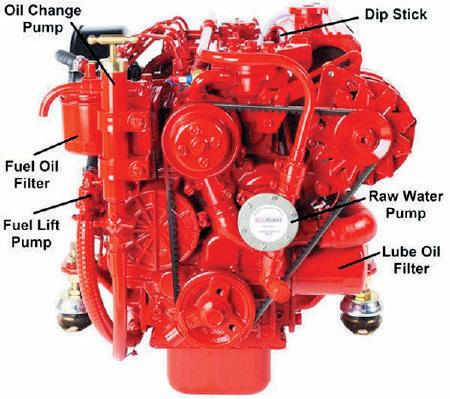
Engineered to be Serviced Easily!

Beta Marine West (Distributor) 400 Harbor Dr, Sausalito, CA 94965 415-332-3507
Pacific Northwest Dealer Network
Emerald Marine Anacortes, WA • 360-293-4161 www.emeraldmarine.com
Oregon Marine Industries Portland, OR • 503-702-0123 info@betamarineoregon.com
Access Marine Seattle, WA • 206-819-2439 info@betamarineengines.com www.betamarineengines.com
Sea Marine Port Townsend, WA • 360-385-4000 info@betamarinepnw.com www.betamarinepnw.com
Deer Harbor Boatworks Deer Harbor, WA • 844-792-2382 customersupport@betamarinenw.com www.betamarinenw.com
Auxiliary Engine 6701 Seaview Ave NW, Seattle WA 98117 206-789-8496 auxiliaryeng@gmail.com
Just a friendly reminder to your readers that generator hours in all BC parks, including marine parks, are 9-11 a.m. and 6-8 p.m. No, there is no enforcement, but if you've been wondering why the folks on the next boat were giving you dirty looks when you ran a genset outside these hours, now you know.
Thanks,
Tim Daniel
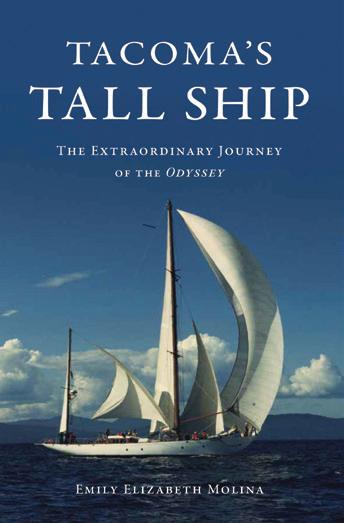
Tacoma’s Tall Ship
Hi Andy,
Hope you are well! I wanted to share my book Tacoma's Tall Ship, The Extraordinary Journey of the Odyssey, which is available on October 21, 2024, with 48° North’s readers.
The Odyssey is still for sale in Tacoma, with a couple of potential buyers, but the book chronicles and preserves her history from east to west, WWII, and more.
All the Best, Emily Molina

Boatbuilding

|


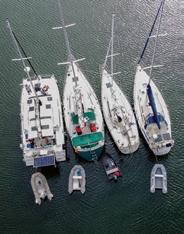


Business or Pleasure, AquaDrive will make your boat smoother, quieter and vibration free.

The AquaDrive system solves a problem nearly a century old; the fact that marine engines are installed on soft engine mounts and attached almost rigidly to the propeller shaft.
The very logic of AquaDrive is inescapable. An engine that is vibrating
on soft mounts needs total freedom of movement from its propshaft if noise and vibration are not to be transmitted to the hull. The AquaDrive provides just this freedom of movement. Tests proved that the AquaDrive with its softer engine mountings can reduce vibration by 95% and structure borne noise by 50% or more. For information, call Drivelines NW today.

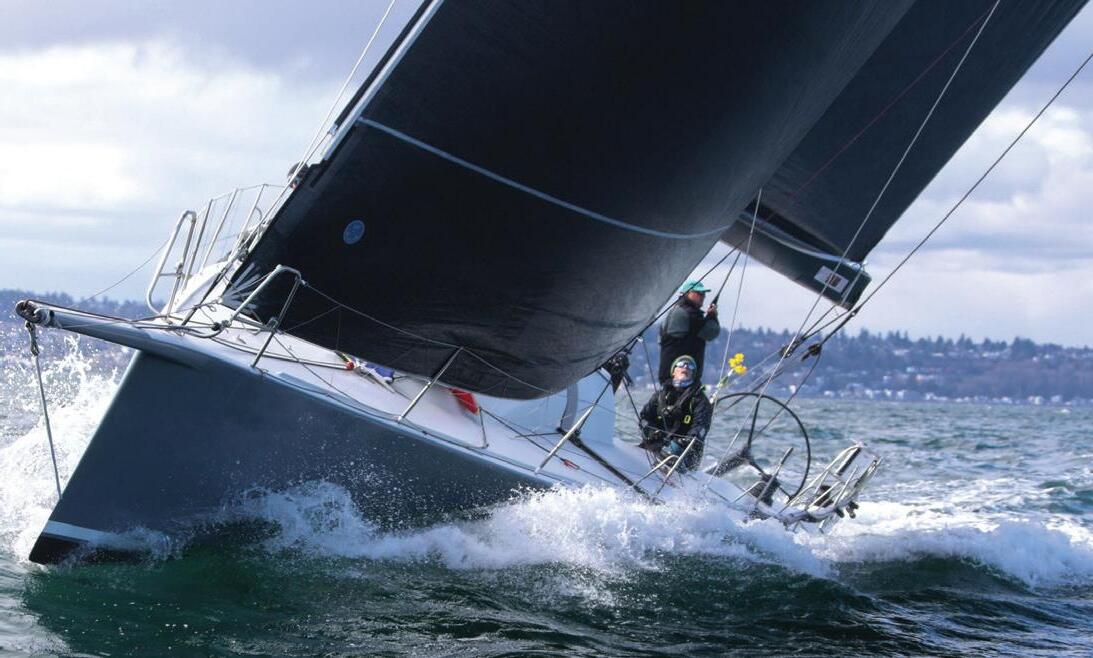

PREMIUM 48° NORTH SUBSCRIPTION
Become a part of the 48° North crew! In addition to your magazine each month, with this exciting new subscription offering, you’ll also be supporting 48° North in a more meaningful way. But, warmed cockles are far from the only benefit. Others include:
• Discounts at Fisheries Supply Co.
• One free three-day to the Port Townsend Wooden Boat Festival ($40 value)
• 10% off of Northwest Maritime Center classes excluding Sailing Club
• Discounts on registration fees for events
• Cool bumper sticker and decals.
• $75/year (additional fees for First Class forwarding or International)
JUST THE MAGAZINE, PLEASE:
Our standard subscription gets you 12 months of 48° North and its associated special publications (SARC, Setting Sail, and the Official R2AK Program).
• $39/year (additional fees for First Class forwarding or International)
by Bryan Henry
Magicians of the reef, octopi can not only quickly change shape and color, they can change the texture of their skin, becoming bumpy or smooth to blend with rocks and seaweed.
When threatened, a squid can squirt an ink cloud that creates a pseudomorph, or false body, that predators dash after instead of the real squid, which by then has escaped.
There are more than 500 species of mantis shrimp, ranging from a half inch to 18 inches.
In certain species of mantis shrimp, it’s the females that aggressively pursue males.
Unlike other flatfish, Halibut are swift swimmers and can easily ascend to the surface to feed.
The Nile catfish swims upside down to feed on algae from the undersides of aquatic vegetation.
1 The entire ship’s company, 2 words
5 Away from the storm, at sea
9 Large winch with a vertical axis
11 Accessory
12 Cloud or other weather phenomena which may indicate an upcoming storm
15 Drain that allows water on the deck of a vessel to flow overboard
19 Reply, at sea- 3 words
24 Be nosy
25 Final point
27 Change the direction of a sailboat
28 Plunge into the water
31 “Ancient Mariner’s” bird
33 Finish, with “up”
34 Coarse beach gravel
35 Hawaiian island
1 Area of a port or harbor
2 Wash against, as waves
3 Back of the boat
4 Beach sights
6 Ease off, as rain- 2 words
7 Arrival time guess, abbr.
8 South American nation
10 Collect data secretly
13 Center of a storm
14 The Nile river flows through it
16 Tax preparer, for short 17 Place
Headed
20 Time period in history 21 Tornado
22 “Life of ___” (2012 movie)
23 _____ circle: instrument used to take bearings of celestial objects
26 Persian Gulf port
29 On an ____ keel 30 Norwegian capital
Pitches
Harbor craft
» See solution on page
Eighty percent of the world’s freshwater fish species live in the Amazon River.
The waters of Australia are home to the Stout Infant fish, no longer than the width of a pencil.
Sailfish and marlins are found in the Atlantic, Pacific and Indian Oceans.
Encrusting sea sponges secrete an acid that enables them to bore into rocks and shells.
Sea hares emit a cloud of purple ink when disturbed.
The Seahorse is the only fish capable of grasping things with its tail.
Seahorses can change colors to match the plant, sponge or coral that they attach to.
Manta rays have been known to leap out of water, sometimes landing in or on small boats and damaging or wrecking them.
The manta ray has been known to produce an embryo measuring four feet wide and weighing 28 pounds.
The word manta is Spanish for cloak or blanket, and when swimming they resemble a spread-out blanket.


Anacortes, nestled in the Pacific Northwest, boasts stunning landscapes, a vibrant coastal community, and a rich maritime history.

by David Casey
While many sailboats double as floating motel rooms for overnight adventures, our Columbia 28 sloop, Ariel , rarely fills that role. The old sailboat seldom finds herself away from her berth for more than a few midday hours when my wife, Laura, and I take her out for a spin. Most of our time spent on the 50-year-old vessel occurs during a Pacific Northwest afternoon, touring the local waters with friends or family.
But every once in a while we stretch our wings (or more appropriately, our canvas) and spend a night in her small V-berth, often after enjoying a barbecue in the cockpit and Scrabble at the galley table. Sometimes, those infrequent overnighters may involve attending local events like the Tuesday afternoon summer concert series in Gig Harbor.
On a particularly beautiful day in late August, we could have driven from our home in Tacoma across the Tacoma Narrows Bridge to the concert site at Skansie Brothers Park in about a quarter of the time it took Ariel to cross Commencement Bay. But a perfect alignment of events prompted us to travel by boat, just as the citizens of Tacoma did up until almost 85 years ago, before the first bridge was built, and then for another decade while waiting for a new bridge after the famous collapse in 1940.
We hadn’t spent much time aboard Ariel in 2024, even though she is our go-to recreational diversion. Since we’d been busy visiting and caring for relatives in California in spring and early
summer, Ariel had seen very few swells and whitecaps across her bow in those prime sailing months. But when our friends Ken and Jeanie, who are avid kayakers, mentioned their plan to view one of the weekly concerts from the water in the picturesque harbor town, Laura and I saw an opportunity.
We also have a kayak, an inflatable two-person model that we keep aboard Ariel, mostly as an emergency dinghy. But in this case, we figured we could sail or motor Ariel to the event, launch the bright yellow tender from the bow, and join our friends in the waters just off the shore near the concert site.
With our plan hatching, we called to reserve a berth at Arabella’s Landing, a top-notch marina with well-maintained facilities, and within walking distance to the numerous shops and restaurants in Gig Harbor. As luck would have it, there were still a few berths available, albeit oversized for our small vessel. We checked the tides, wind, and time, with favorable numbers on two out of three conditions. With the wind barely above a whisper, Ariel’s sails remained snuggled under their covers, their power usurped by our motor. We threw together some snacks, drinks, and our overnight bag, headed to the marina, and got Ariel underway in minutes.
Having tuned up our small Yamaha 9.9 outboard in the spring, we cruised along at nearly 5 knots, sharing our journey with a solitary fishing vessel at the north end of the narrows, and a cabin cruiser that looked like she was heading to the same event. Just southwest of Vashon Island, our short trek gifted us with a visit from a small pod of harbor porpoises before we slowed to our final destination.
Navigating through the narrow opening of Gig Harbor was manageable at high tide, although tales from members of our sailing club prompted extra caution. We’ve heard stories of experienced sailors running aground just off the northern spit of the entrance, with its ornamental miniature lighthouse belying its symbolic purpose.
Once in the harbor, we cruised past pier after pier jutting out from restaurants and homes, each one overflowing with vessels moored by vacationers or residents. Concerns about an unmarked entrance to our berth were allayed when our Navionics app pointed us to our overnight destination, allowing us to enter the marina past the massive cruisers dwarfing our homey sailboat.
After adjusting and retying our docklines, we headed to the marina office to check in. The host informed us about the amenities and services at the marina and along Harbor Drive, the street that runs parallel to the shore. We were hesitant to tell her that we lived just across the narrows, a 15-minute drive away. But when we explained that we wanted to watch the town’s weekly musical event from the water, her response put us at ease.
“What a great idea to get away for a night. Have fun at the concert!”
We pumped up our kayak, which our friends have humorously named Flounder after the Disney character in “The Little Mermaid,” and enjoyed the requisite salami, cheese, and crackers at our galley table as we waited for Ken and Jeanie to arrive.
After receiving their arrival text, we paddled Flounder out to meet them and two additional friends, Rod and Jamie, along with the couple’s cute dog, Cora. We arrived early in the protected waters near the public dock, and there were few other boats to navigate through. But as the musical group completed its sound check before the start of the show, elbow room was tight, with motorboats, paddleboards, and gondolas jockeying for position.
We tied up to a pier within earshot of the stage and the six of us shared more picnic fare and travel stories while the band got the crowd going with several Jimmy Buffet tunes. When they shifted their repertoire from familiar tunes like “Margaritaville” to something less intoxicating, Jeanie suggested that we go for a paddle to the lighthouse to work off dinner. We had the bay to ourselves, and it seemed that the entire population of Gig Harbor was at the concert or aboard their cabin cruisers or at vacation homes.
When we got back to the middle part of the harbor, we said our goodbyes and headed back to our boat. Though home wasn’t far away, we found comfort and coziness in Ariel’s cabin, and settled in after discussing plans for the next day’s journey back home.
Checking the tides for our return trip to Tacoma, we knew that leaving early would prevent motoring against the current as we headed east to our home marina. Since Laura and I are early risers, we were ready to cast off before 7 a.m. after finishing our coffee and granola.
With Flounder securely nestled on the foredeck, we snuck Ariel quietly away from the dock, trying not to wake our friendly neighbors in their Nordic Tug. As we approached the mouth of the harbor, we knew our course would have to be more judicious
The gondola crosses the harbor while kayaking from Arabella’s Landing to the concert at Skansie Park.

than the one we took the previous night. Avoiding the flood tide meant the depth was ultralow, and we held our breaths as the depth sounder display plummeted to single digits, numbers we had never seen before!
After making it through the narrow opening unscathed, we found ourselves in the open waters of Commencement Bay, heading toward the cliffs of Point Defiance and a beautiful sunrise within the mottled, cloudy sky. The journey home was one of the many highlights of the brief sojourn, with the calm, quiet waters of Puget Sound allowing a moment of peaceful contemplation.
As we cruised close to the shore, we passed far more fishing boats along Owen Beach in the early morning hour than on our previous day’s reverse route, and we jostled for position with the Vashon ferry before entering the marina. Once moored, we deflated Flounder and buttoned up Ariel, readying her for her next journey, whether it be another overnighter to attend an evening festival or simply a short cruise in familiar waters.
On Puget Sound, we’re so fortunate to be near our home, but out on our boat as well.
David Casey is a retired math teacher and semiprofessional woodworker and bass player. He plans on using his retirement to build a small sailboat and a kayak, and to explore the waters of southern Puget Sound.
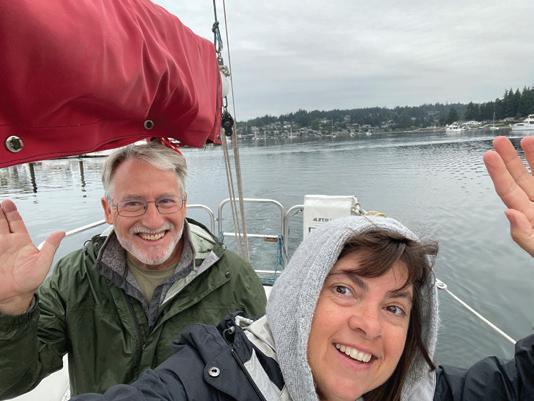
The author and his wife take a quick picture while leaving Gig Harbor early in the morning under cloudy skies.

by Solvig Sayre
Last summer, I was in the parking lot of the hatchery on the Washington side of the Columbia River, talking to a wingfoiler on the tailgate of his red pickup truck after a beautiful day on the water. I mentioned how I was looking forward to course racing coming to wingfoiling and he was surprised because, to him, it was a purely recreational sport. I acknowledged that it was a sport that was invented with absolutely zero designs towards racing, and that the original designs were so inefficient and the concept of raceworthy VMG was incomprehensible. I told him that it was a new sport that I was tackling and that my soul ached to race again. It didn’t ache for the desire to win, but for what competition does.
What is most important about competition, for me, is the community and teamwork that it takes to have a competition, and the learning
opportunities that come with it. Even in individual sports, you and your fellow competitors are all working as a team to create the best competition possible. You are aware that everyone’s success helps with your own personal successes. This is especially true in sailing.
Good competition should be rewarding for all who participate, and the way we as sailors understand this quality form of competition is by learning about effective leadership and teamwork, and then applying those principles in the competitive setting. All the trust, cohesiveness, and mutual investment that happens within a boat’s crew is, in many ways, the same kind of trust, cohesiveness, and mutual investment that we are looking for from our competitors on the race course. In its finest and most honorable form,
competition looks like teamwork. We trust that our competitors are playing by the rules and are not out to get us, but rather there to share in the joy of the game and the sport. Such good-hearted competition is what keeps people coming back. Cutthroat competition will do just the opposite. There’s a rising tide to competition done right, and it’s something that racing sailors of all ages should strive for.
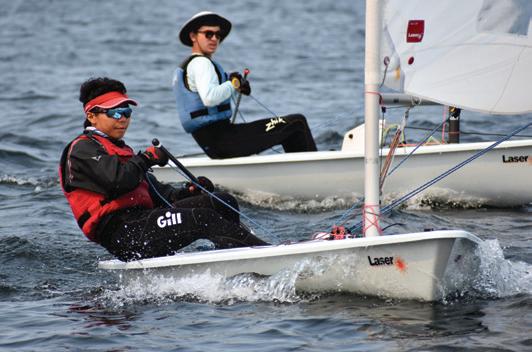
When you are able to have respect for your fellow athlete, rule compliance, and the self discipline to continue to improve, you will have the best version of competition. There is no sailing race without your competitors, without agreement on the rules, and, most importantly, the shared goal. I was always most motivated to do my best when my competitors were also trying their best. It is a special community you build when you have a shared goal, and that is where I find the most joy in competition.
There are a myriad of other reasons to enjoy competition. Psychologists point to the fact that never ending steppingstone goals are a key to happiness. Sports, especially in competition, provide that. You learn how to sail, then you learn how to race, then you learn to race at a regional level, then you learn to race at a national level, and on it goes. It provides an opportunity to prove to yourself what you are capable of, and can push you to be your best. Exposure to new horizons—literally and figuratively—is another reason why even very novice sailors often desire and value opportunities to compete.
Hand in hand with competition, sailing provides an incredible opportunity for youth to develop life skills. Beyond the standard teamwork skills, sailing provides a physical and intellectual exposure to an array of interests. There’s the marine biology that you witness from the unique vantage point of a boat and the meteorology that is markedly important to a sailor. It might also inspire an interest in cartography, like it did for a colleague of mine.
Some lessons are even learned before we get out on the water. One of the most
influential land drills I did as an athlete waiting for wind, was when my coach threw a bunch of tools on the workbench and had me learn all the names. It was a simple but needed confidence boost for all the repairs I would need to do to my equipment, which gets me to chemistry. Fixing fiberglass and carbon fiber boats requires a chemistry lesson with bonders, accelerators, additives, and all types of things to make the repair. You have to learn what fulcrums and purchase systems are, how to maintain them, and how to maximize their effectiveness. There’s the obvious lesson in physics to make the boat move forward in a desired direction, not to mention all the types of engineering.
On the water, the learning never stops. Teaching two sailors to fly the spinnaker or to get crew out on the trapeze is really an art in teamwork and leadership, which will help when they start competing together. It shows how leadership is not about one person taking charge and making demands, it is about making each other get better. If you make it easy for your crew, your crew will succeed and, in turn, make it easier for the skipper in an endless cycle of improvement. You need to communicate clearly, listen to each other, add additional information, and calculate each other’s strengths, weaknesses, and fears. You also have to trust each other and take self-responsibility for your own role. There are far too many things happening on a trapezing boat with a spinnaker for both people to be trying to accomplish the same task.
When I was coaching sailors how to fly the spinnaker in a 420, a big part of their instruction was about communicating their needs, when they had accomplished their

task, and where they needed to be looking. The person at the crewing position needed to communicate that he didn’t think the spinnaker had enough pressure. Then the helm position needed to communicate that she was heading up in response to that need, so that he could adjust the sail, or if she couldn’t or didn’t feel it was the right decision to head up, she had to tell him to make it work until something changed and then they could give him what he needed for the spinnaker to be effective. In the jibe, it was important that at least one of them was always looking at the spinnaker, they could not both be looking at the line they were passing to each other. They had to communicate who had possession of the line and know when a task was completed so that at least one of them could be looking at the spinnaker. The confidence sailors gain from overcoming challenges such as these is what motivates me to coach, as do many others. It is incredibly rewarding to watch a child’s confidence grow as they struggle to learn to sail at first, then pick it up and take off, and eventually succeed in racing with their group of peers. The look on their face when they do well in sailing and then in competitions is proof that their life has changed forever because they accomplished something so hard. And that’s priceless.
Solvig Sayre is the Youth Sailing Director at The Sailing Foundation, where she works with programs around the Pacific Northwest. She has extensive experience on the US Sailing Team and leading youth programs around the country. Check www.nwyouthsailing.org.

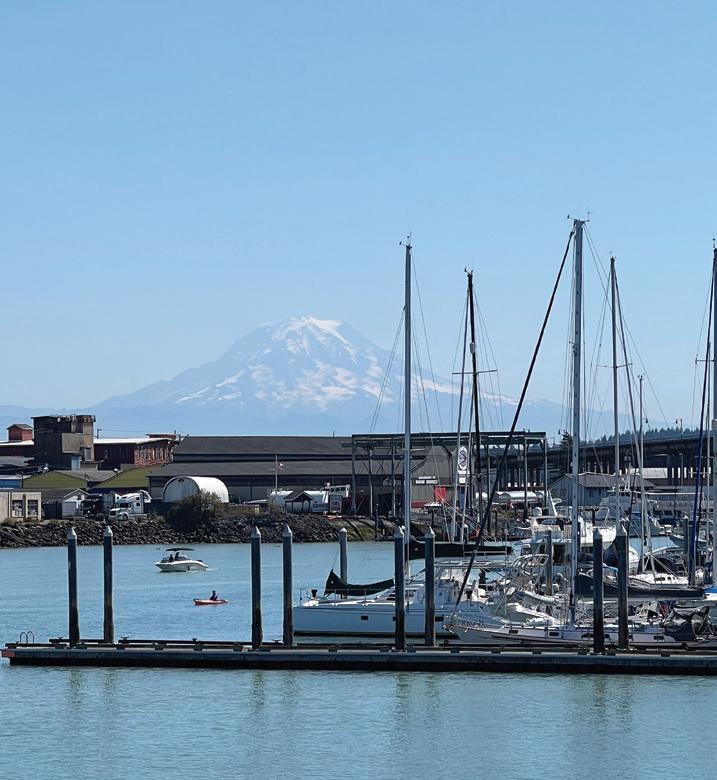
n the list of great destinations for a weekend cruise on Puget Sound, Tacoma might not immediately spring to mind.
But that didn’t deter us when we found ourselves without plans for the Labor Day weekend. The forecast was calling for sun and high temperatures, and we were itching to get out on the water. We were in the mood to go somewhere with dining options and interesting sights, where we could stretch our legs on a long urban walk. It had been more than a
decade since we’d been down to T-Town, so Tacoma it was.
Under a dazzling blue sky early Friday afternoon, we pointed the bow of our Passport 40, Rounder, south from Bainbridge Island toward Mount Rainier. We sailed down scenic Colvos Passage, flanked by forested Vashon Island on one side and the Kitsap Peninsula on the other, across Commencement Bay, and into the Thea Foss Waterway on Tacoma’s eastern shore, the mountain providing an ever-closer majestic backdrop.
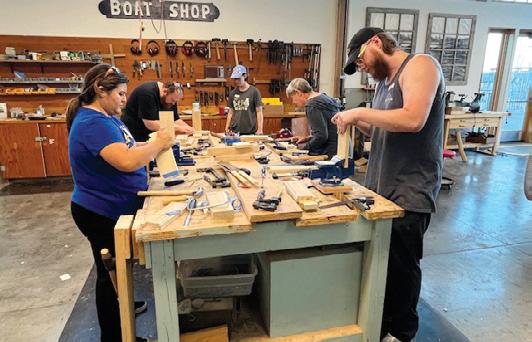
by Deborah Bach
Once a thriving industrial area and the western terminus of the Northern Pacific Railroad, the heavily polluted Thea Foss Waterway was largely abandoned by the 1980s and declared a Superfund site. An extensive cleanup effort completed in 2006 helped revive the waterway, which now has condos, marinas, and a waterfront trail among the commercial and industrial buildings.
We’d hoped to get a slip at Dock Street Marina, ideally situated next to the Museum of Glass, and a short walk to downtown shops and restaurants. We’d stayed there previously and had a great experience, but alas, the entire marina was booked for a yacht club meet-up.
After a few phone calls, we discovered that we could stay less than a mile north at the Foss Waterway Seaport dock, which offers four hours of free moorage ($1 per foot after that) and has power and water.
Pulling up, we were surprised to find the 1,200-foot linear dock empty aside from a couple of boats. An even bigger surprise was the seaport’s museum next to the dock. The once-decrepit, centuryold warehouse building, which was undergoing an extensive renovation on our previous visit, had been transformed into a modern, airy structure fronted by a wall of windows that beckons visitors in.
The museum was closed when we arrived, but we poked our heads into the
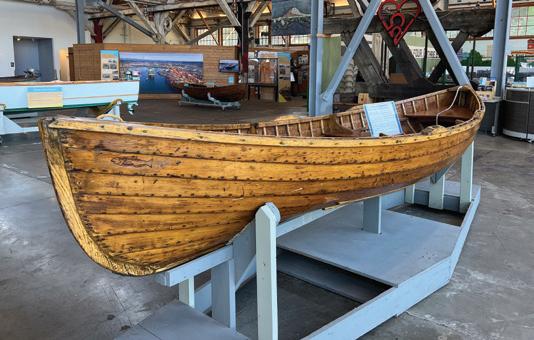
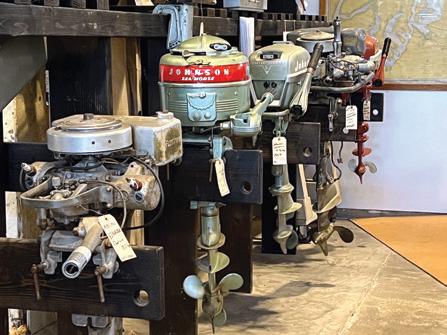
boat shop, where a handful of students were taking a class on dovetail joinery. We’d met the boat shed manager, Cori Shooter, earlier on the dock and she’d told us about the variety of classes at the shop, from beginner woodworking to fiberglass and epoxy repair, and to diesel engine maintenance. Impressed and excited to visit the museum in the morning, we headed off for some downtown exploring.
Tacoma has several historic districts with beautiful old buildings—among them, the 1916 Elks Temple downtown that is now a seven-story McMenamins adult playground with a hotel, brewery, restaurants, and several bars, including a faux speakeasy down a hall behind a door concealed in a wall panel. After cocktails at the not-so-secret speakeasy, we walked a couple of blocks uphill to Devil’s Reef, a nautical-themed tiki bar in Tacoma’s Opera Alley, a narrow street lined with charming old buildings. The wonderfully kitschy, dark bar was full (with, appropriately, a rum launch party) so we left with plans to return on a future visit.
After breakfast and coffee the next morning, we headed to the museum and spent an enjoyable hour or so wandering through its exhibits, which provide a fascinating snapshot of the area’s maritime history. Boats on display include several unique Pacific Northwest designs—the “Poulsbo boats” named for the town where they were built, the Ed Monk-designed flat-iron skiff, and a lapstrake skiff built in 1912 by Andrew Foss, who founded Foss Maritime with his wife, Thea.
There’s a collection of antique outboard motors, an informative exhibit on Puget

Sound’s Mosquito Fleet, and a vintage SCUBA exhibit featuring early diving equipment and a 1970s wetsuit worn by Jacques Cousteau that caused Marty and I (who both got SCUBA-certified on Puget Sound, where Cousteau dove and filmed) to geek out in delight. The museum is a gem, and a must-see for anyone interested in Puget Sound’s maritime history.

Afterward, we hopped in an Uber and headed to the farmers market in the Proctor District, a neighborhood in the north end of town, for some produce and pastries from a Swedish bakery. We fueled up with coffee, then walked back toward the seaport through leafy neighborhoods with beautiful Victorian houses and through Wright Park, a lovely 27-acre expanse with walking paths and big trees.
Wanting to stretch out the glorious afternoon a little longer, we stopped at Rock the Dock Pub & Grill, located on the
The author’s cat, Lily, enjoys the view of Thea Foss Waterway from the top of the
water just north of the seaport museum. We got a table on the deck, ordered bloody marys, and soaked in the views of Mount Rainier and the waterway. Despite the prime waterfront location, the place was pleasantly low-key and unpretentious, the type of joint that has meat bingo on Tuesdays and a clientele that looked to be largely locals.
Back at the boat, we sat in the cockpit and reflected on the great weekend we’d had. It wasn’t exactly a peaceful environment—the Tacoma Spur freeway was just a few hundred feet away and is evidently a favorite place to race extremely loud motorcycles and cars— but the noise was part of the experience. Tacoma still feels working class and a little gritty, reminiscent of Seattle in the pre-Amazon days. Authenticity is part of its charm.
As we talked and our boat kitty, Lily Winston Churchill, surveyed the scene from atop the dodger, the steamship Virginia V pulled up to the dock behind us. Launched in 1922, it is one of only two ships in Puget Sound’s Mosquito Fleet still in existence. Its appearance seemed fitting, a reminder of the city and region’s rich maritime heritage.
With its wonderful maritime museum, beautiful old buildings, interesting neighborhoods, and ample dining and entertainment options, Tacoma arguably deserves a spot on the list of great Puget Sound boating destinations. I hope it won’t be years again until we return.
Deborah Bach is the co-founder of Three Sheets Northwest and a former newspaper reporter. She and her husband can often be found sailing with their boat kitty on their Passport 40, Rounder.
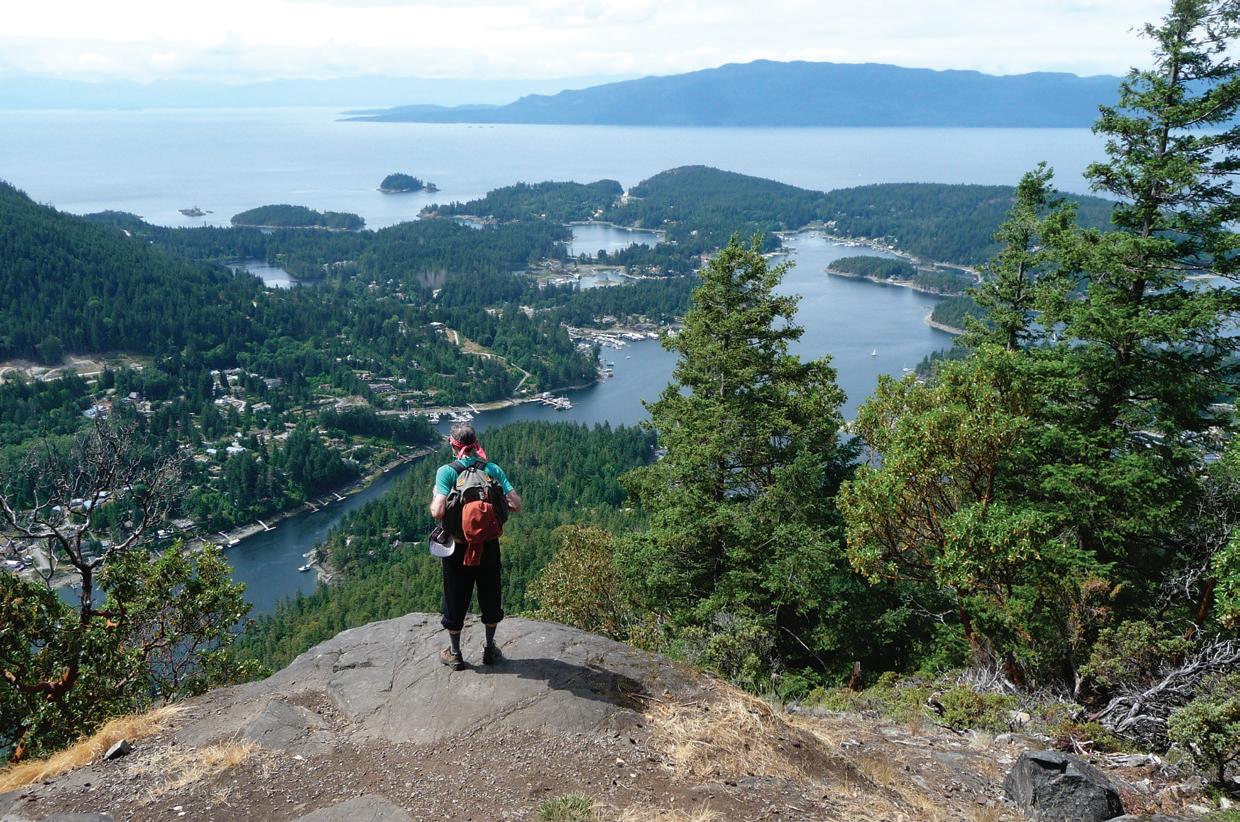


On the way to Desolation Sound, there are several locations north of Nanaimo where boaters can stop to break up the long trip. Some of these also have excellent hiking opportunities and are worthy of a longer stay. The places I mention in this month’s column are ones that we have stopped at many times and think of as destinations in their own right.
Southeast winds seem to be common when we’re northbound in the early summer, so we usually cross the Strait of Georgia from Nanaimo and head north along the mainland shore. There are many sheltered inlets along this stretch of the Sunshine Coast, the first of which is Smuggler Cove Marine Park. Its entrance is very intimidating, only 80 feet wide with a cliff on one shore and reefs on the other, but it is deep enough and totally calm once inside. It is divided into three small bays, which in some places are quite shallow or have hidden rocks.

Fortunately, there are stern tie rings around the shore that allow a surprising number of boats to moor in the limited space. Stern tying is pretty much mandatory in the summer.
Our favorite hike starts at the southern shore of the cove and wanders along the rocks and shoreline of first the cove, and then the shore outside the cove near the entrance. It’s not a long walk but covers lots of interesting terrain, our favorite being the tide pools when the tide is low. Heading the other direction, the trail also goes a short distance east past a wetland before meeting a road in a half mile or so. This road also makes Smuggler Cove a popular destination on warm summer days for locals wanting a little fun on the water.
Pender Harbour is a large bay with two government docks, marinas, yacht club outstations, and a number of arms where anchoring is possible. But it’s a heavily-populated area and comes with some challenges. The first is working around the many boats that are permanently moored here. The second is gaining access to the shore, since most of the land is private. And the third is getting to the hikes, all of which require significant amounts of road walking. We usually anchor in Garden Bay or Gerrans Bay, depending on which hike we want to do. Garden Bay is conveniently located but small and very busy; anchoring on short scope is pretty much a necessity.
The premier hike in the area is Mount Daniel. This is the tall, rocky bluff directly above Garden Bay—in fact, it is part of the Garden Bay Marine Provincial Park and there is a trail to the top of the bluff. That’s the good news. The bad news is that the trailhead is located on the other side of the peak from the bay and requires a several-mile road walk around Garden Bay Lake to get to it. The road can be accessed from the provincial park dinghy dock near the center of the bay. The trail is straightforward, though steep, and ends atop the bluff at 1,400 feet.
The panoramic views are outstanding, from Pender Harbour in front to Texada Island, the Strait of Georgia, and Vancouver Island in the distance. The hike is about 8 miles, two-thirds of
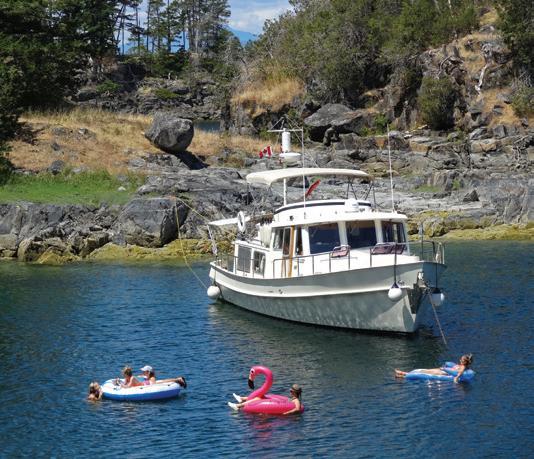

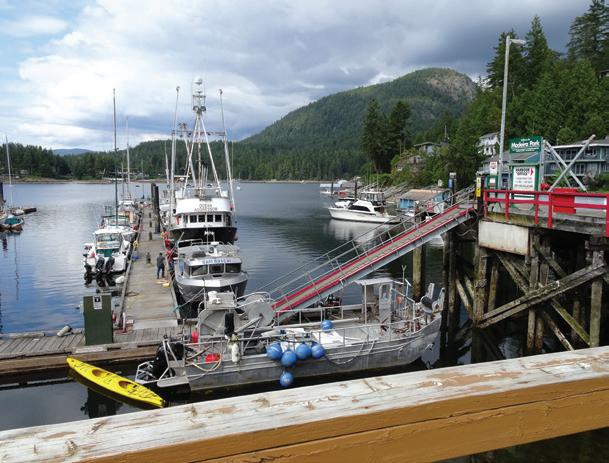
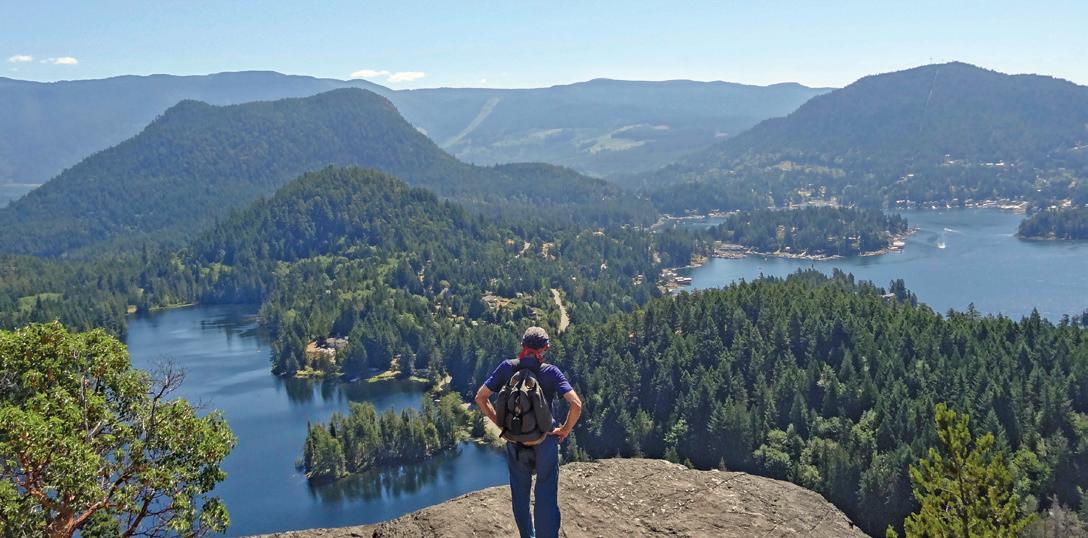
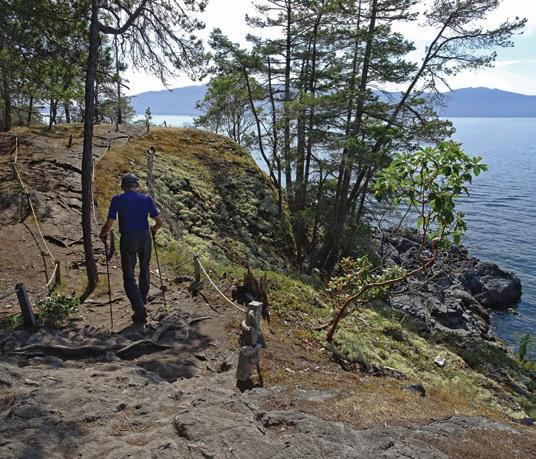
which is along a road. We are always footsore from this hike, but we keep coming back. From Garden Bay you can also hike to the top of Pender Hill, which overlooks the entrance to the harbor but is only half as high as Mount Daniel, so the views aren’t as expansive. And there is still a lot of road walking to get to the actual trail.
From the government dock in Gerrans Bay, a more modest road walk brings you to Francis Point Provincial Park, with trails through forest ending on the shore of Malaspina Strait at the Francis Point lighted beacon. The part of the hike along the shoreline among beautiful madrona trees is particularly nice. Since we row our dinghy, we usually anchor in Gerrans Bay for this hike, though we will moor at the public dock if there is space available.
Tribune Bay, on the south shore of Hornby Island, is on the Vancouver Island side of the Strait. It is wide open to southerlies

and Qualicum westerlies, so we usually wait until the winds are reliably out of the north before deciding to come here. Tribune is a wide, beautiful bay over a sand bottom so gently sloping that a half-mile from shore the water is still only 30 feet deep. There is plenty of anchoring room for many boats—we’ve seen more than 80 on a summer day, with everyone well spaced out.
The beach has beautiful sand and is very busy in the summer, since there are car ferries that go to the island. There is a spectacular hike here, but first you have to get ashore. Between the high and low tide lines there are several hundred yards of sand, which is a long way to drag a heavy dinghy. Instead, we usually use our kayak since, after being unloaded, it is light enough for the two of us to carry up to the driftwood. Once settled ashore, we can look up at the tall sandstone cliffs lining the east side of the bay and contemplate the hike.
The outer tip of the peninsula on the east side of the bay is Helliwell Provincial Park. From the beach, there are several trails that go to the road, and a short walk east takes you to a private road through a housing development called High Salal. You can hike up this road to lot 17, where a public trail right-of-way goes west, then walks along the top of the cliffs. Soon the terrain changes from thin forest to grasslands as you cross into the public lands of the provincial park. Spectacular clifftop views, forest trails, shoreline walking—they are all there in abundance in Helliwell, and on excellent trails. A loop encompassing most of the park is about 7 miles, with around 3 of it walking the roads between your landing spot and lot 17. Despite the road walking, we love this spectacular hike and try to return every year.
Michael and Karen have been cruising the Salish Sea and beyond for more than 20 years, hiking every chance they get. For more resources for hikers, visit their website at https://mvmischief.com/library/
For additional hiking information on the islands in this area, Michael and Karen also recommend Hiking the Gulf Islands of British Columbia by Charles Kahn.





by Lisa Nickel
My mom has always said, “Boating is never a vacation; it’s always an adventure.”
That proved true for our family of four while cruising the San Juan Islands during the summer of 1978. Mom and Dad had anchored our 26-foot wooden Trojan powerboat, Wesley Ann, in a calm Jones Island cove for the night. We had the place all to ourselves and enjoyed a quiet evening playing card games by lantern light.
The next morning after breakfast, Mom and Dad let my younger brother and me row to shore alone in our Columbia dinghy for the first time, something we’d been begging to do for days. Wearing classic old orange life preservers, Charlie and I set off. I took charge and rowed the short distance while three-year-old Charlie sat as a lookout in the bow.
When we got to shore, he jumped first with the rope and pulled the rowboat up onto the barnacle-covered beach like a pro, then we secured our craft to a driftwood log. We had just taken off
our life jackets and were walking along the beach when … KABOOM! Deafening thunder clapped behind and above us. We just about jumped out of our skin.
Eyes wide, Charlie called to me over the fading rumbling, “Lisa! What was that?”
Our eyes darted up into the thick island forest.
Before I could speak, my brother’s wild imagination answered his own question. “Giants are coming through the woods to get us!”
Panicking, we turned and looked the
other way out at our boat. The Wesley Ann floated calmly in the anchorage. We could see our parents standing on the stern, motioning for us to come back.
Without a word, my brother and I ran back down the beach to the dingy. Charlie untied the bow line and I pushed our rowboat into the water. Our little craft rocked as we jumped in, while more thunder boomed overhead.
“Put your life jackets on!” Dad called to us over the rumbling thunder.
I flung my life vest over my head, not taking the time to fasten it. All I could think of was getting away from monsters as fast as I could. Charlie threw his life jacket over his head backward. I took the strongest pulls on the oars as my 10-anda-half-year-old arms could muster.
We got back to the Wesley Ann in record time, and Mom and Dad assisted us aboard while lightning crackled and thunder continued. Lit up by the morning sun shining from underneath, the clouds gave off a golden, green-gray glow tinted in purple. The salty air smelled like static electricity.
Just as Mom and Dad hauled the dingy
Oh, those life jackets! The author and her brother sport classic, old canvas PFDs stuffed with goose feathers.
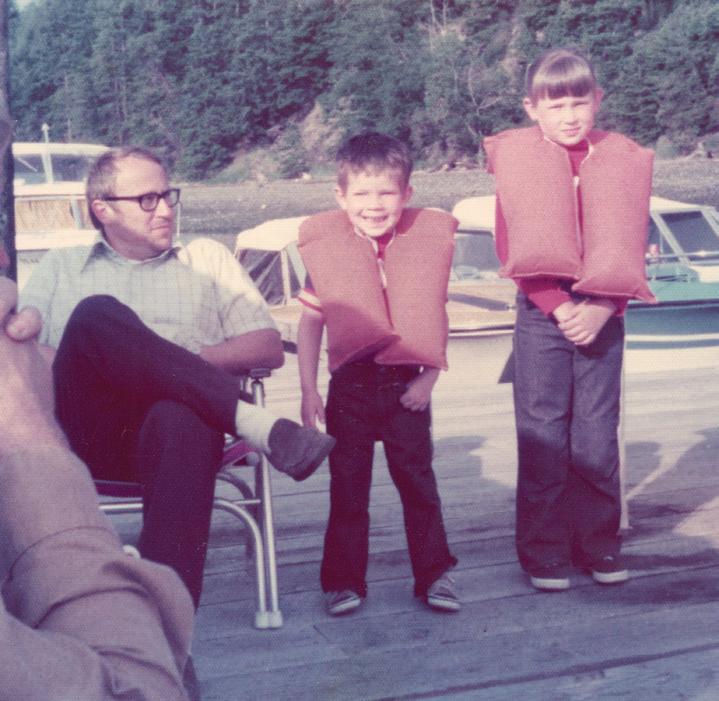

up onto the swim step and secured it, the rain started. Large drops splattered down onto our little floating home, drenching everything almost immediately.
Our plan was to dock at a marina in Fisherman Bay on Lopez Island later that day. Dad warmed up the engine, Mom hauled up the anchor, and we set off for the safety of the marina a few hours earlier than planned. As we exited the calm shelter of Jones Island, rough water overtook us. A north wind whipped up whitecaps in Spring Passage, blowing spray over our bow. Dad, wearing his trusty bucket hat low over his eyes, navigated from up on the flying bridge with Mom as copilot.
Charlie and I, our life jackets now fastened correctly, sat at the galley table with our worry-rocks we had collected the previous day. I had selected four dark gray, oval beach rocks polished smooth to be my pet rock family. Charlie had found some, too.
“Do you think we’ll be OK?” Charlie asked, his hands anxiously rubbing his rocks.
“Yeah, Dad knows what he’s doing.”
In 1949, two experienced boat builders, Jim McQueen and Harper Hull, left Owens Boat Company with the dream to start their own custom boat building business in York, Pennsylvania. McQueen and Hull purchased the Cottrell-Spoore Boatworks of Troy, New York and renamed their venture Trojan Boat Company. They employed highly skilled Amish craftsmen to build wood boats in a converted dairy barn.

As Trojan Boats expanded, they purchased and then moved to a factory in Lancaster, Pennsylvania in 1953. The company opened a second boat building operation in Elkton, Maryland in 1965 with a focus on larger vessels. By 1968 Trojans from 14 to 47 feet were being produced in Lancaster, Pennsylvania; Elkton, Maryland; and in Niagara-on-the-Lake, Ontario, Canada. This made Trojan Boat Company the second-largest producer of inboard boats in the world. The Trojan Boat Company produced wood and then fiberglass pleasure craft until it was purchased by Miramar Marine in 1992.
Tacoma, Washington resident, Don Leonard, purchased his 1968 Trojan in 1974. He named this lapstrake hull design by combining his two children’s middle names. The Wesley Ann was built in Lancaster. She was 26 feet long, 10 feet wide, and drew 30 inches of water. The vessel was powered by an inboard 185hp Chrysler 273 V-8 engine. Leonard remembers his engine cranking up to 5000 RPMs at the blink of an eye. “We had no speedometer back then, but it was fast,” he recalls.
Every Trojan was unique. The company prided itself in customizing each boat to individual specifications. Wesley Ann sported teak decks with teak cabin interior woodwork. Wesley Ann was outfitted with an old-style “flasher” depth sounder, a compass, and paper charts with charting tools. “That’s all we needed to get around Puget Sound in those days,” Leonard remembers.

I had complete faith in my father. I never doubted we would be in danger with him at the helm.
With both hands on the wheel, Dad navigated us through the winding channel into the bay. Our little vessel dipped and rose as we crashed through waves. We soon entered the protection of Fisherman Bay, and the whitecaps lessened while the rain poured.
When we approached the marina, Dad radioed the dock master. “Wesley Ann to harbormaster. We have arrived and are ready for our reserved slip.”
I sat stunned by the muffled reply from the bridge radio. “Harbormaster to Wesley Ann. Because of the sudden storm, the boat in your reserved spot has not left yet. Be advised to anchor and wait out the storm.”
I looked toward the docks and could see that all the slips were filled. Presumably, none of the boats had left due to the storm. We would have to anchor and wait.
The lightning continued around us while thunder boomed and rain poured down. Once we were safely anchored, Dad turned the engine and batteries off. He lowered the radio antennas and turned off every switch on the boat. The wind continued to increase, making the water choppier in the sheltered harbor. We sat rocking in our little Trojan’s cabin, waiting and listening to the storm.
And then it hit!
A huge bolt of lightning crackled straight down, slamming into our boat. For an instant, the cabin was lit by bright white light. Every speaker on the boat crackled, though they and the batteries were shut off. We looked at each other in panic.
The Leonard family of four slept snuggly in the V-berth. Other luxuries onboard Wesley Ann included a sink in the galley with cold running water, an ice box, a two-burner alcohol stove, and a small head, all with cabin warmth from the heat off the engine. The Leonard family felt as if they were cruising in luxury.
A crew aboard an anchored sailboat off our stern had watched in horror. The skipper shouted over the wind, “You guys OK?”
“We’re OK,” Dad yelled back, giving a thumbs-up through our cabin door toward the sailboat.
Miraculously, although shaken, none of us sustained any injuries. And amazingly, the Wesley Ann seemed to come out of the incident without damage. Our trusty wooden boat had protected us and saved us from being hurt. The skipper of the nearby sailboat later said that when the lightning struck, the water had boiled all

around us, radiating and bubbling out in every direction.
Eventually, our nerves subsided along with the storm. Our reserved moorage slip opened, and we were never so thankful to have our dad navigate the Wesley Ann to the safety of a marina as we were that day.
Our wood vessel had been our shield. We were all fine and lived to admit that Mom was right—boating is never just a vacation; it is always an adventure.
Lisa Nickel grew up boating out of Tacoma on the tugboat Teal and believes there was no better way to grow up. Today, she is happiest when spending time with her husband, daughter, and family. She is working on a middle-grade novel about a girl on a tugboat, and is co-authoring an Arcadia Publishing “Images of America” book on the historic Olympia tug, Sand Man, with Chuck Fowler.

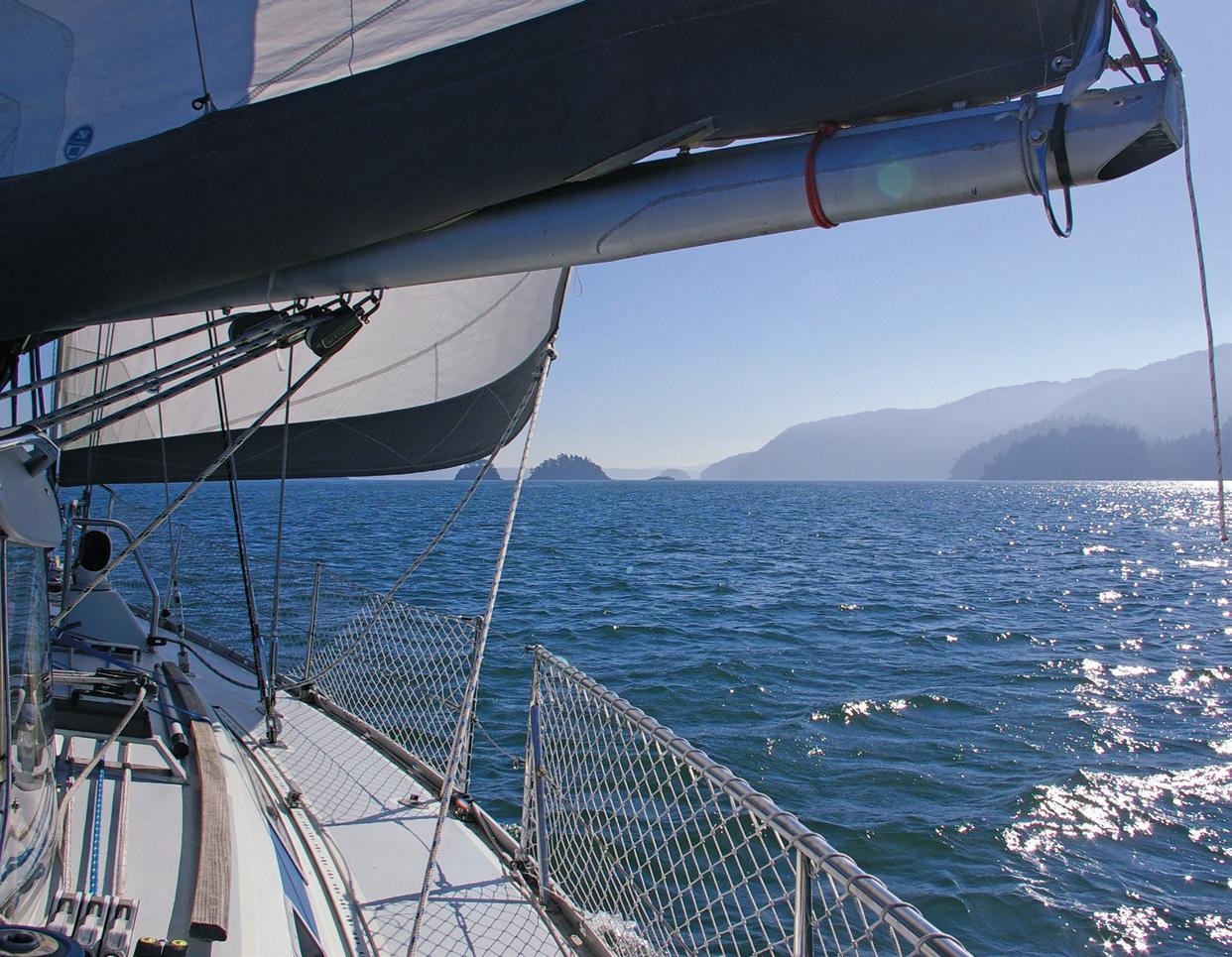
by Andy Cross
The first big fall storm arrived in the Pacific Northwest recently, and the images and stories it brought to mind were familiar. While living and cruising our Grand Soleil 39, Yahtzee , throughout numerous winters on the Salish Sea, I imagined heading to one of several trusted anchorages that we used to wait
out blustery weather. Some of those storms weren’t very fun to experience, but the times in between, when the magic and moods of winter appeared, we had some truly extraordinary moments. Though storms like these obviously do happen, don’t let them deter you from getting out on the water to spend a week or weekend at anchor. With the proper heating setup keeping your boat cozy, there is a certain wondrousness that
comes with being out during the change of seasons. The key is paying close attention to the weather, and finding the right spots for the conditions.
In the October 2019 issue of 48° North, I wrote an article about some of my favorite winter anchorages in Puget Sound. Now, here are a handful of my favorites starting in the Bellingham and Anacortes area, and working westward into the San Juan and Gulf islands.
This is a special stop for our family for various reasons, and we only ever anchored here in the offseason. In the late fall and early winter of 2014, we cruised through the San Juan Islands and Anacortes/Bellingham area in anticipation of the arrival of a new crew member. My wife, Jill, was pregnant, and our midwife was in Bellingham. So we needed to come to town for appointments every two weeks until our second son, Magnus, joined our family on December 27. Our routine was to head out into the islands for about a week to 10 days and then sail back to Bellingham for the appointments. In doing so, we found a number of great anchorages to hideout near Bellingham Bay, and Chuckanut Bay was perfect because it has spots that are protected from the north and south. Boaters from Bellingham are well aware of these beautiful anchorages that sit below Chuckanut Mountain, but I’m not sure that many other folks are. After all, the nearby San Juan Islands seem to collect most cruisers that are on a schedule, which leaves other off-thebeaten-path locales a bit more open. If you’re looking to take cover from a big southerly, the southwest corner of the bay is absolutely perfect. Here, pint-sized Pleasant Bay is flanked by a nearly sheer shoreline with private

homes nestled amongst the trees. Depths are moderate, and we anchored here numerous times in about 30 feet. Prevailing winds are typically out of the southwest and we sat through a blow of about 35 to 40 knots one night without really noticing it. Something to note is that all of the shoreline is private. But even though you can’t stretch your legs ashore, we had fun paddling around the perimeter of the coves in our kayak. To go ashore, head north.
At the north end of Chuckanut Bay you won’t find perfect protection from strong
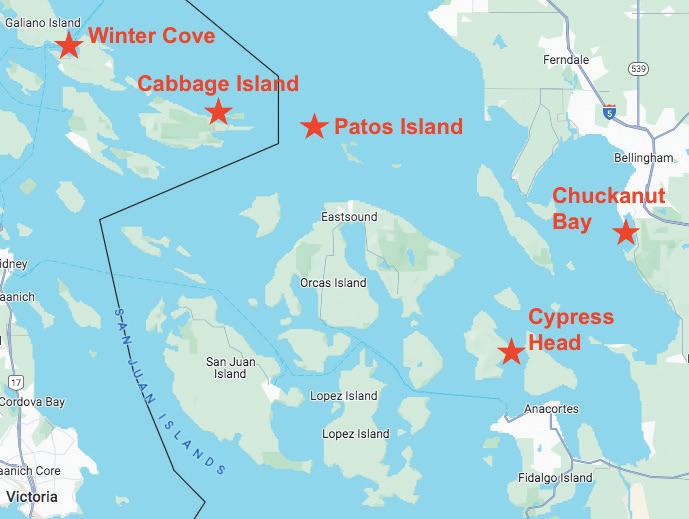
winds, but it’s still pretty good. You can drop your hook up in the northerly corners in about 25 to 40 feet and the nearby train trestle will greatly reduce fetch. (The sound of the train isn’t much of an annoyance.) And if you want to anchor here in a moderate southerly, you can tuck all the way up to the western shoreline north of the charted rock to gain some relief.
In this section of Chuckanut Bay there are two spots to go ashore. Take your dinghy or kayak under the bridge at high tide, and head towards the
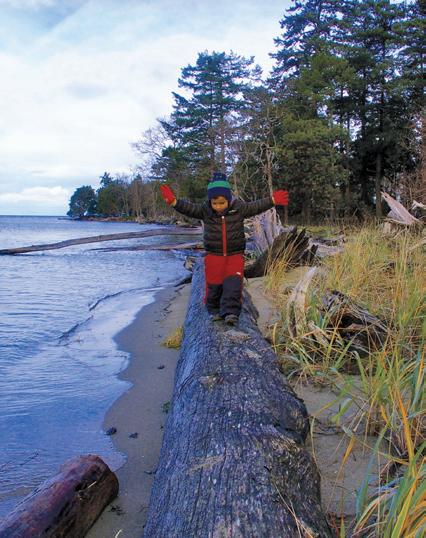
The author’s son, Porter, enjoys time ashore on a winter day.
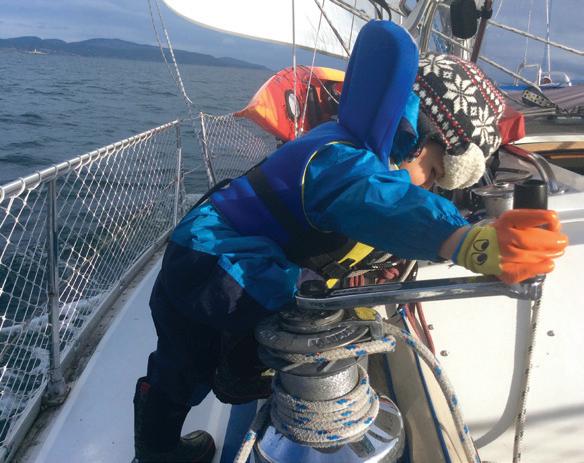
northeast corner of the bay. There is a public park here to land your tender and, from there, you can walk up the road to Chuckanut Drive. Just be sure to head back out before the tide drops or you’re stuck—and that is some sticky mud! The other place to go ashore is at Teddy Bear Cove Park, where you can land your dinghy on the small beach near a set of wooden stairs. The point that juts out into the bay is covered in twisted madrona trees, and the rocks are fun to poke around in. From here you can hike to your heart’s content. A maintained trail leads across the railroad tracks, and then towards Bellingham or up Chuckanut Mountain, which affords sweeping views of the San Juan Islands.
Even in the winter, playing on the beach is a highlight.

It was late in the afternoon when we sailed south down Bellingham Channel with Cypress Island to starboard and Guemes Island to port. As we neared the north side of Cypress Head, I rolled up the jib and then turned into the wind to drop the mainsail. There were no other boats in the mooring field, and we motored slowly towards the farthest ball in while closely watching the depth sounder. I could soon tell that the mooring ball was in shallower water than our 6.5 foot draft would allow for, and I turned hard to port to get back into deeper water. We ended up anchoring just outside the mooring field and had a comfortable night’s sleep.
Close to Anacortes, Cypress Head

became a favorite place to pop into for a night or two. Located on the eastern side of Cypress Island and south of Eagle Harbor, there are a few mooring balls on the north side of the tombolo and room for anchoring outside of that. Along with the shallow water that comes up quickly as you approach the beach, the other concern here is current—it rips around the head and swirls into the mooring field and anchorage.
With a small campground located on Cypress Head, this is a popular spot in the summer, but far less so in the shoulder and offseasons. We loved walking the adjacent trails, and combing the rock and sand beaches on both sides of the tombolo.
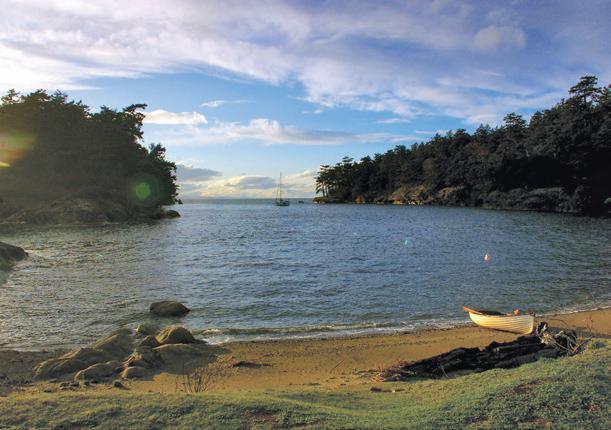
It was mid-January and pouring buckets when we sailed north from San Juan Island to Patos. Given the weather, it was no surprise that we didn’t see a single other cruising boat for the two days that we were there. The northernmost isle in the San Juan chain, Patos is a small marine state park with one narrow harbor that has two mooring buoys, some campsites, a USCG lighthouse, and that’s about it.
Anchoring is possible here, but given that there were no boats on the moorings, we chose to pick one up instead. Going ashore on the beach and walking out to the lighthouse, we were stunned by the massive amount of juvenile and adult bald eagles that wheeled overhead and hung out in the trees. Being the lone humans around, it felt like we were their guests. A highlight of Patos in the winter is the trail that takes you out to the lighthouse and then loops through the middle of the island. It feels like you’re a world away from civilization until you look out and see a passing ship heading for Vancouver.
The sun burst through the clouds as we motor-sailed into a strong current between tiny islets in the Gulf Islands. Once clear of the islands and out in Boundary Pass, the wind started piping up and we easily made the decision to fly our spinnaker. With the big blue sail rigged and flying, Yahtzee took off like a shot and we hugged the Canadian side of the pass heading eastward towards the corner of Saturna Island. After an hour or so of smooth sailing, the clouds behind us turned dark and we could sense a squall was building that would soon overtake us. It did, but we were able to pull the spinnaker down and stow it before the majority of the wind and rain hit.
After rounding East Point on Saturna and turning into Tumbo Channel, we fought the last of the ebb while watching bald eagles soar overhead. A few miles up the channel, we made our turn through a reef, and came into a small bay between Cabbage and Tumbo Islands, which are part of Canada’s Gulf Islands National Park. We’ve anchored here before, but being that it was winter, ten empty



mooring buoys awaited and we had our pick of the litter.
We spent the better part of three days moored between the islands and Cabbage quickly became one of our favorites in all of the Gulf Islands. Small and low-lying, the island is ringed by diverse beaches that range from fine sand to small pebbles and hard sandstone. The sand, of course, was perfect for our boy’s beach toys, and we spent a gloriously sunny morning digging and then hiking around the island. There are no true hiking trails on Cabbage Island, so the best way to explore it is to walk around the perimeter. This walk is best done at low tide, as there is more beach exposed, but we did it at both high and low tides, and felt that each offered a completely different experience. The middle of the island is made up of marshes with stands of madrona, garry oak, and Douglas fir trees interspersed throughout. And the island’s flora is an important nesting site for black
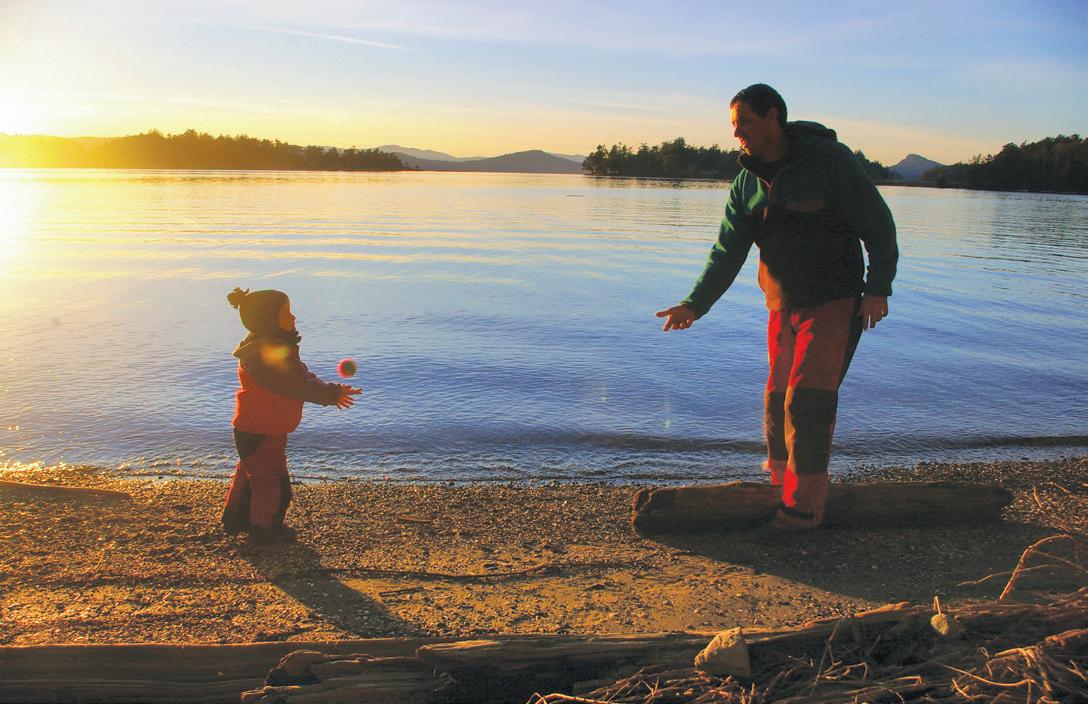
oystercatchers and bald eagles. Except for the birds, seals, and an occasional freighter passing in the distance, there were no other signs of life on or around the island. It is one of those places that we always want to return to—especially in the winter.
I’m not simply mentioning Winter Cove in an article about winter anchorages because of the name, but it certainly is great in the offseason. Most experienced Gulf Islands cruisers know Winter Cove as a bustling summer anchorage that hosts an annual lamb roast on July 1st. While it’s fantastic in the summer, it takes on a whole new demeanor in the winter.
After a stop in nearby Ganges, we found ourselves here just in time for a good bit of southerly wind that abruptly shut off overnight and then, lo and behold, the sun made a grand appearance. Our family scurried to shore to play football in the grass, and hike the nearby trail to watch the current rip out through narrow Boat Passage. Backed by forested Douglas fir upland, open meadows, and a salt marsh, the trail loops through the forest and then along the Winter Cove shoreline to the open waters of the Strait of Georgia.
That evening, we decided a fire and s’mores would be appropriate, and we got it crackling while watching the sunset. As the sky lit up through a range of stunning reds, oranges, and pinks, it was one of those moments in between winter storms that made being out there so incredibly worth it. There truly is nothing like the Salish Sea in the winter.
Andy Cross is the editor of 48° North. After years cruising the Pacific Northwest and Alaska with his family aboard their Grand Soleil 39, Yahtzee, they sailed south and are currently in the Caribbean Sea. You can follow their adventures at SailingYahtzee.com.
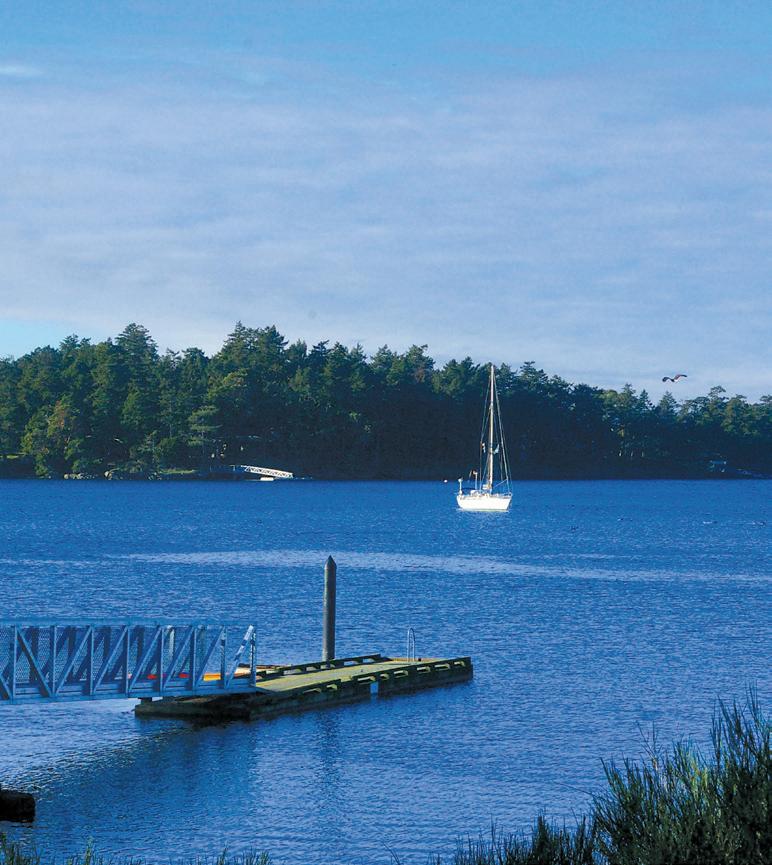
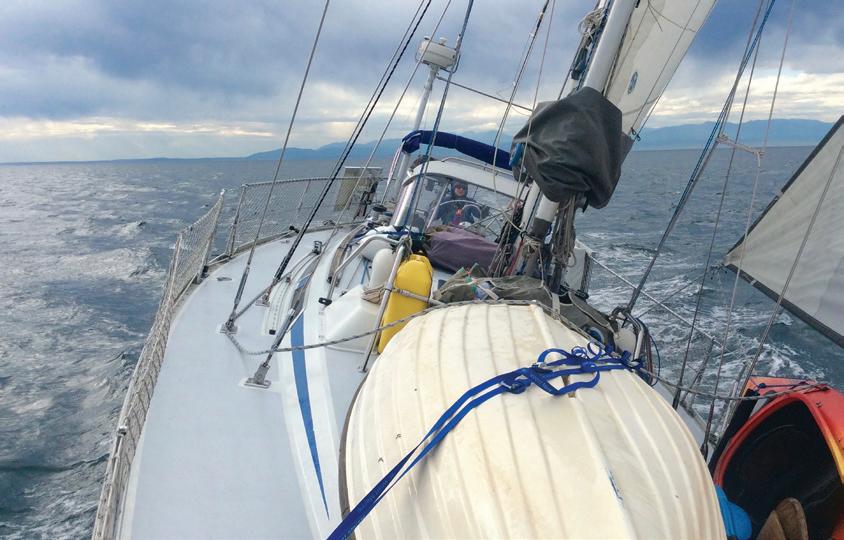
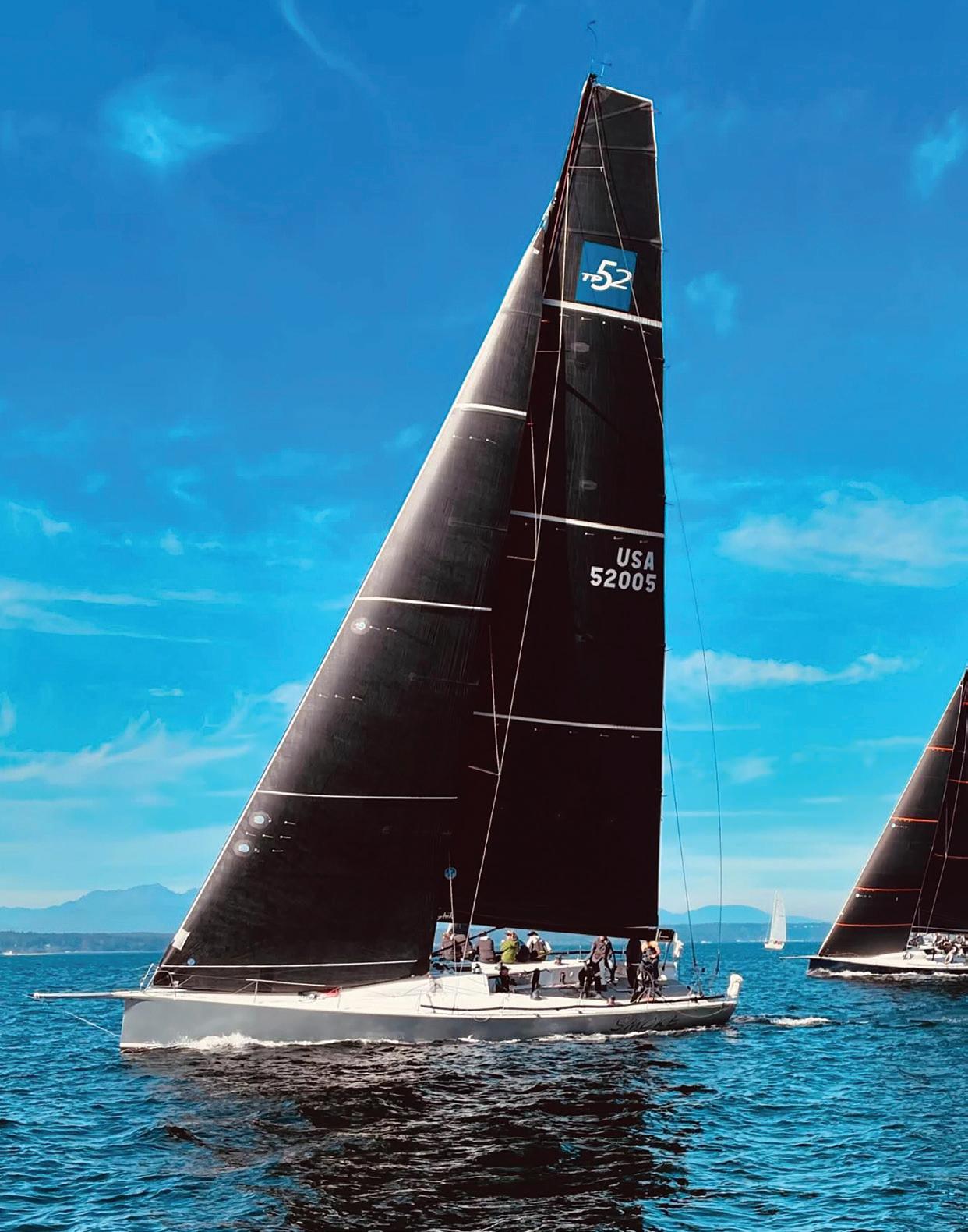
PICTURESQUE FALL WEATHER BRINGS CLOSE RACING IN JUST ENOUGH WIND
For many racers in Puget Sound, this is one of the first races of what is usually a flurry of great events hosted across the region in the fall. Sailed two weeks later than usual this year, the Puget Sound Sailing Championship (PSSC) is typically marked by tight competition and professionally-run buoy racing. And, of course, great views and drinks served at the CYC clubhouse afterwards.
The forecast promised a beautiful Pacific Northwest fall weekend, with abundant sunshine and warm temperatures. Although it didn’t quite deliver as well for those of us looking for wind; PRO Charley Rathkopf and his enthusiastic crew of race committee volunteers at CYC started this year’s PSSC with a 1-hour shore delay.
Right on time, at the original first warning time of 11 a.m., several boats could be seen actually sailing in what just a few minutes prior had been a glassy Shilshole Bay. Race committee took the bait and set out, though not very far. What little wind could be seen was all close to shore and left no room for a race course. On the J/109, Lodos, we motored out around noon and quickly saw the breeze disappear again. Another hour of waiting and some solid wind had filled in, as long as you didn’t get too far out.
The 4- to 6-knot northerly that had filled in allowed Meadow Point to work its magic, making the breeze seem more powerful than it was. The committee worked fast to get a course set for all fleets and racing started about 1 p.m.
With a fairly short course set in the bay, there were not many passing lanes in the two races that were run. The acceleration of breeze off Meadow Point seemed to dominate the day with most teams looking to get to the beach at Golden Gardens and the breakwater on the way up and down the course. The two races were run in quick succession, in surprisingly stable, though light breeze. The short course and its close proximity to the breakwater meant many fleets were overlapping and there were some tight, tricky mark roundings.
Results going into Sunday were tight across most of the seven fleets racing. The wind forecast was anyone’s guess, with “light” and “variable” being the words of the day. As the fleet motored out for an attempt at an on-time start, we were met by sun and even more warmth than Saturday. A light and shifty easterly was showing as the race committee motored north before

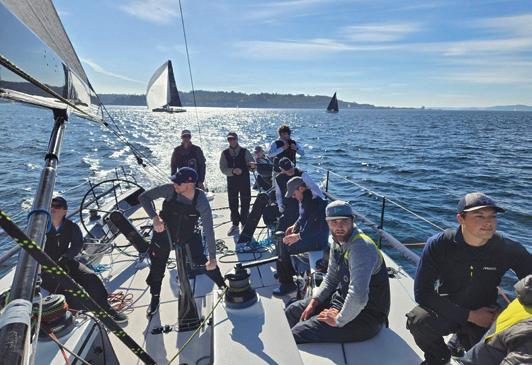
eventually settling into a spot inside Shilshole Bay again. The wind eventually settled into a more southerly direction with more velocity than Saturday, allowing for a longer course to be set. One long race was run after a short delay. With a persistent shift heavily favoring the inside corners, the race committee was proactive in resetting the windward mark for the second lap for most fleets.
The competition was tight, with many fleets seeing lead changes from Saturday to Sunday. On Lodos we had an excellent start and, knowing that we were in a tight race with Uno, Nefarious, and BOO, with limited chance at more racing, we were out to make it count. As the fastest rated design in a PHRF fleet, we kept it simple, picked our sides, and looked to keep clean lanes off the fleets ahead.
The course and wind were anything but simple, with 20-degree shifts from inside to outside and a tide line that split the course as well. We were able to have a clean race and finish, and corrected to first. Most fleets saw close finishes in consistent wind. And with the wind still looking promising, race committee appeared to be considering more racing before making the decision to head to the bar. Just in time, too, with the wind well and truly dying just as most of us made it back to the dock.
PSSC 2024 may not have set any records, but it definitely exceeded expectations and served quality racing in picturesque fall weather. Full results are available at www.cycseattle.org.

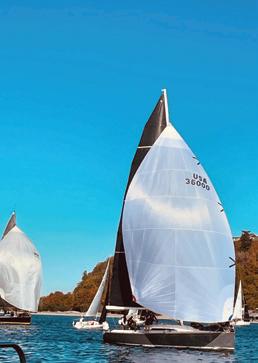
Though the wind was light, there was just enough to fill spinnakers.
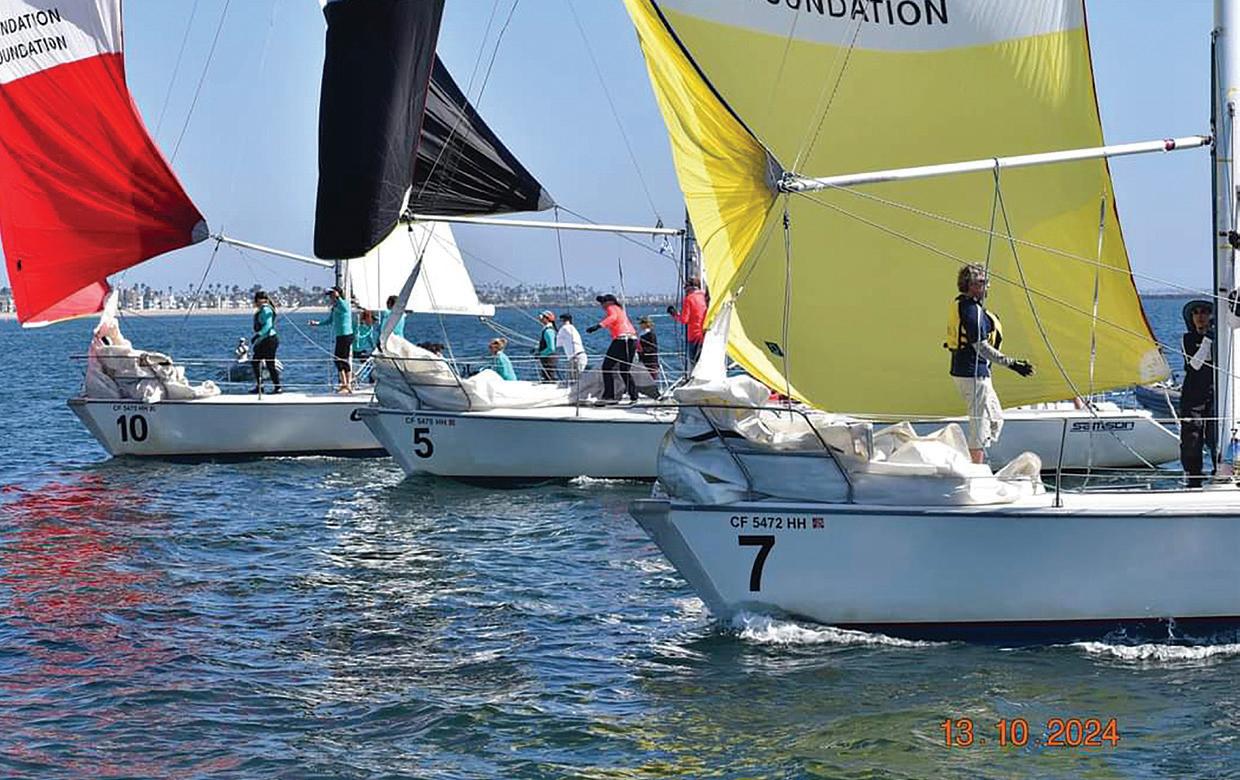
This write up has been composed in collaboration by the Northwest Maivens: Molly Howe, Stephanie Campbell, Taylor Joosten, Emily Bishop, JJ Hoag, Melanie Edwards, Emily Hawken, Genevieve Fisher, Elishia Van Luven, and Vikki Fennell.
During the weekend of October 1213, a group of sailors from Puget Sound migrated south to the palm-lined, sunny shores of Long Beach, California, to compete in the Linda Elias Memorial Women’s One Design Regatta (LEMWOD). As the premiere women’s fleet racing event on the West Coast, it regularly draws Olympians, match race champions, and college All-Americans from the most elite yacht clubs and teams, mostly from California and Hawaii.
The Northwest Maivens sailed proudly under the burgees of the Sloop Tavern Yacht Club and the Port Townsend Sailing Association, and with massive support and sporting team gear from Kate Hearsey at Maiven Sailing. With the indomitable Molly Howe at the helm, the team showed up ready to put themselves on the line, and in true PNW fashion, where we take our racing seriously, second only to the amount of fun we are having.
The regatta is by invitation after an application process and submission of resumes because the event is sailed in a 10-boat fleet of Catalina 37s, owned by the Long Beach Sailing Foundation. We spent the practice day on Friday fast tacking, coordinating maneuvers around marks and through jibes, working through starting sequences, and tuning up with the other boats.
Corralling 10 people from different cities to practice is nigh unto impossible before these events, so having a practice day to try different scenarios and rigging options is clutch. Not to mention, that some of the team had never sailed with each other before. There are times when things just work—this year at LEMWOD felt like that—which isn’t to say that everything went flawlessly, it never does. Having the space to learn, the knowledge to pivot, and the intention to grow makes all the difference in the world. When 10 people are paying attention

Melanie Edwards, Taylor Joosten, Stephanie Campbell, Emily Bishop, Molly Howe, Genevieve Fisher, Elishia Van Luven. Bottom Row, Left to Right: Vikki Fennell, JJ Hoag.
and anticipating the next moves, even mistakes go away quickly.
After our practice sail, we returned to the harbor under full canvas, taking advantage of the perfect weather to sail and dance to some bops. The team had a concise but constructive debrief, which included Taylor and Molly leading us in reflection as we went round the group sharing our high tide and low tide of the day, quickly finding we didn’t have many lows but were eager to put all we learned into action on race day. We endeavored to mingle with the other teams with varying degrees of success.
Most of the teams kept to themselves, but we definitely started to chip away at the Long Beach Freeze after a few well-earned beverages. It certainly helps when the entire team vibe is effervescent and delightfully hilarious.
On the way out to the race course the next morning, as we listened to our playlist of walk-up songs, someone realized that the boats had no names, only numbers. So, of course, as is custom in Northwest sailing lore, the roll of black electrical tape was retrieved from a gear bag and the naming of boats commenced. The Catalina 37s are a 30-plus-year-old fleet that have been sailed hard and put away wet, so in the spirit of the event, camaraderie, and admiration for those that came before, we chose Ethel as our moniker. We imagined that Ethel had probably seen some things, and named her with the hope that we all will still be racing just as hard when our own names are equally vintage.
The definition of a “maven” is one who is experienced or knowledgeable, and Northwest Maivens were “hot to go” and showed our stuff right out of the gate on Saturday. Molly, Stephanie, and Taylor worked together on tactics to get a clean start in clear air; the team coordinated on tight boat handling and secured a third place in the first race. Proving to the rest of the fleet (many of whom have been sailing the boats and the event for 10+ years) and ourselves that we absolutely deserved to be there. After the race they would announce the finishers in order over the radio and I loved hearing the cheer from our boat when they said, “Third place, Sloop Tavern!” The other teams were probably thinking, “What is Sloop Tavern?” But after that first race, we certainly had their attention.
downwind. But the racing was so tight that even a small reduction in boat speed meant that the more experienced teams were already there capitalizing.
Emily reflected that, “The real joy was seeing a group of highly skilled sailors, many of whom had never sailed together before, seamlessly perform at a really high level. A big part of our success was proactive communication. Molly set a great precedent for starting and ending each day with conversations about what we were doing and how we could improve, and everyone else on the crew gave productive feedback for all of us to continually streamline our maneuvers. We spent a lot of time anticipating things that might go wrong and talking through what we could do to avoid them rather than taking a reactionary approach. There wasn’t a single ego on board, and we all jumped in wherever we saw a gap to keep the boat moving.”
Vikki at the same event in 2016, by jumping in the yacht club pool; mostly clothed, just as they had done all those years before! As expected, the Maivens made friends with the bartenders and wait staff at the regatta dinner hosted by LBYC, and predictably persuaded the club manager to give us the code to the stereo system. We proceeded to DJ and dance, grabbing as many of the servers and sailors from other teams as possible to join the rumpus in the middle of the main dining rtoom. The Northwest Maivens didn’t just win the party, we were the party!
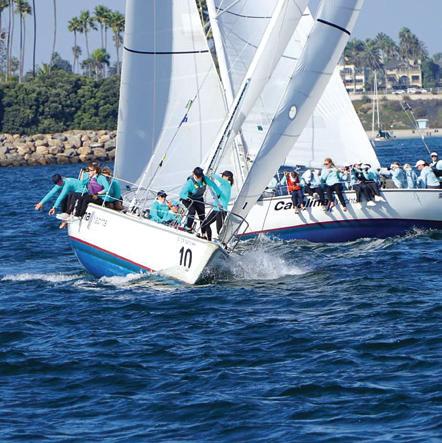
As day one progressed, we had high tides and low tides in our results as we learned how skilled the other skippers were at starting, how quickly the Catalinas slow down in any sort of bad air, and how much power they need to get up and go. Without local knowledge, we gathered data and experimented, finding that we were on par with regard to boat handling and boat speed, and tactically in the mix, often making gains
From the jump, our boat handling and communication were solid, and we spent the day focusing on small tweaks and adjustments to try to squeak out every bit of boat speed and get more efficient with maneuvers, all the while having a blast with smiles for days. You know it’s a good time when the call for the pole and spinnaker up around the windward mark evolves into, “Tits up, Ethel! Nice and perky!” The Maivens ended the day feeling pumped for more racing.
Back at the dock, Elishia and Emily somehow convinced the rest of the team to recreate the moment of their meeting
After an early morning tradition of renaming the other boats (a sign of respect in our local sailing culture) and an on-the-water dance off between teams as we waited in postponement for the wind to fill, we were ready to see how much more we could improve on day two. The Catalina 37s are sensitive to weight placement, and we were getting progressively better at backing the jib and throwing our weight around as a group as we roll-tacked the heavy 37foot boats. Molly and Stephanie were nailing the starts, and race two of the day had us in a jibing duel with Hawaii (who were winning overall) on the last downwind leg, merging right at the finish line and sneaking out a photo finish in front of them. We were impressed that our team could do that many jibes—not an easy maneuver on this boat—and not lose any distance on them. On the dock, their team came over to tell us that, “You were a force to be reckoned with out there! We kept crossing and saying, ‘There’s the Sloop Tavern team again! We couldn’t shake you!’”
As soon as the final race finished, the whole team was in agreement that we wished there was more racing because we had really started to gel and figure the boat out. A review of the final results revealed that we finished sixth overall and beat every team at least once, which left us hungry and eager for next year!
In Molly’s words, “High tide: Putting together a team that became cohesive, literally overnight, and an abundance of skills and beautiful spirits. Also, our ability to come out sailing a clean regatta. Low tide: It ended too soon!”
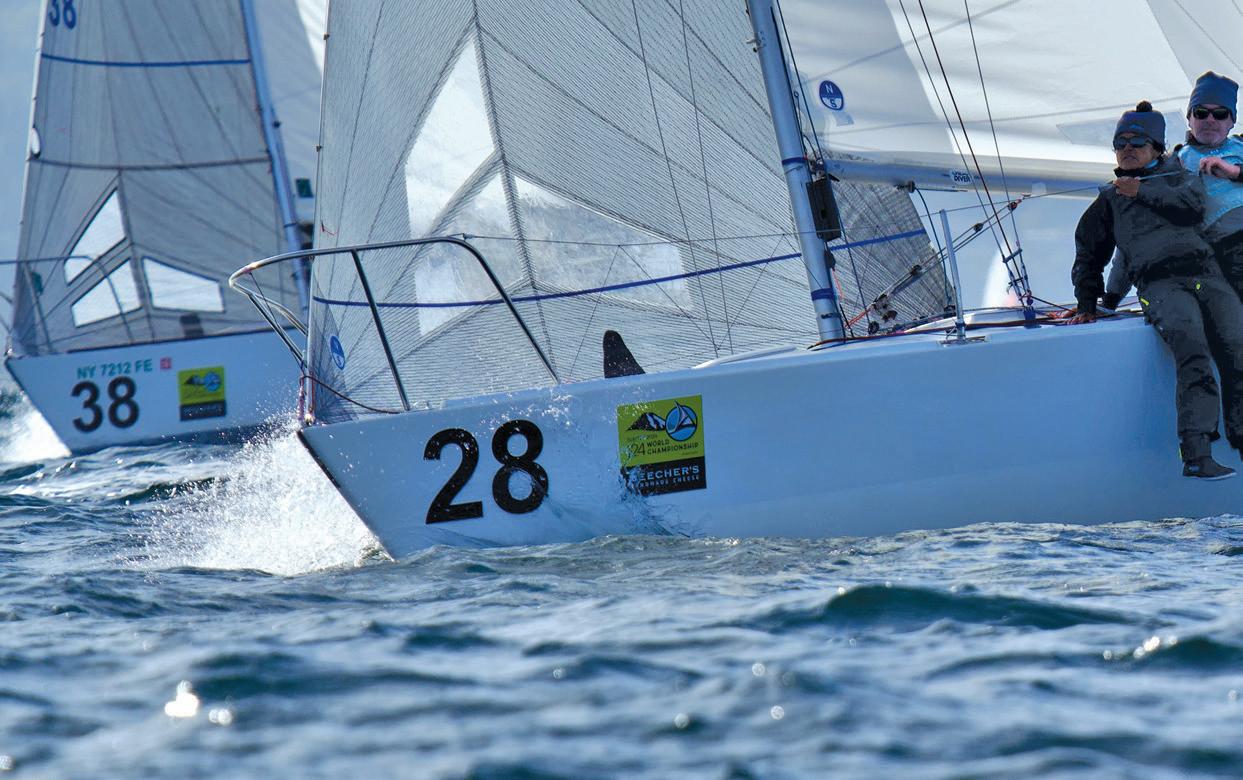

by Jay Leon
As of October 5, the J/24 class has a new world champion. Travis Odenbach and his Honeybadger team from Rochester Yacht Club came out on top at the 2024 Seattle J/24 World Championship presented by Beecher’s Handmade Cheese. Honeybadger won the last race by what looked like a mile, after having led the 56-boat fleet since mid-regatta. Regardless of their finishing order, sailors young and old who came to Seattle for the event were rewarded with nine races over five days in the full range of conditions and daily after parties onshore.
Reflecting on his World Championship title, Odenbach recognized the great contributions of his teammates. When asked how he won, Odenbach said, “Obviously, with this team. They are the best team I have sailed with, and they are best friends. Dave Hughes, Monica Morgan, Jeff Sullivan, and Jay Miles… I am thrilled to have this team.”
J/24 sailors came to Shilshole Bay from 11 countries to compete in this championship that has been hosted every year since 1981 in iconic racing venues from Sydney, Australia, to Lake Garda, Italy. The J/24 may have been the very first J/Boat ever designed, but it is still the largest one design keelboat class in the world, and to emphasize how the class is still attracting new members: 10 of the 56 teams were under 25 years old or all female.
Winning the J/24 Worlds is no small endeavor as Mike Ingham will tell you. This year, he took home the second-place trophy
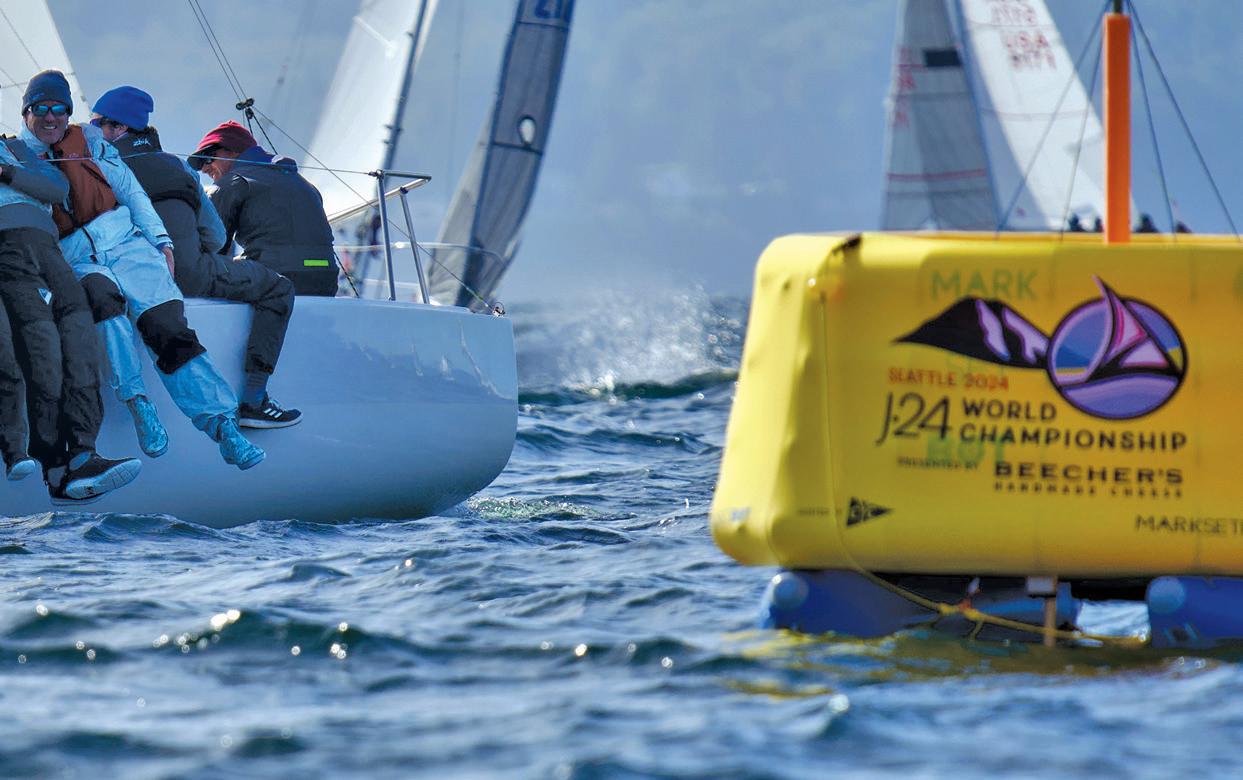
for the third time. Mike led the regatta after the second day, but could not answer the back-to-back first-place finishes recorded by Honeybadger on day three.
Going into the final day, with eight races completed, the first and second places were established, but Nobukuki Imai and his team on Siesta were sitting in third place with only four points separating them from their home country rival, Kohei Ichikawa on Gekko Diana
When the starting gun sounded for the start of the ninth and final race, the new Vakaros RaceSense GPS starting system flagged Siesta over early. Even though this new system communicated “OCS” and “Clear” immediately, taking away the usual uncertainty when a boat jumps the gun, it was still a big setback for the Siesta team.
Siesta worked back from OCS to 18th, but Gekko Diana scored a second-place in the race and took third place overall. The fateful early start almost shot Siesta out of the top five, but they held onto fourth place by just one point ahead of a tie for fifth, which Jakob Lichtenberg’s Hair of the Dog won by tiebreaker.
The competition on the water was heated with plenty of vocal, elbows-out aggression on the starting line, but there were no general recalls thanks to the expert work by Principal Race Officer, Mark Foster, who shared the credit with his new tools when he said: “We used a lot of technology in this regatta. The Vakaros RaceSense starts the races for us. I call the line but I rely on them to give me the actual numbers. The Mark [Set] Bots were amazing because I was able to use one for the pin and square the gates so they were never out of whack.”


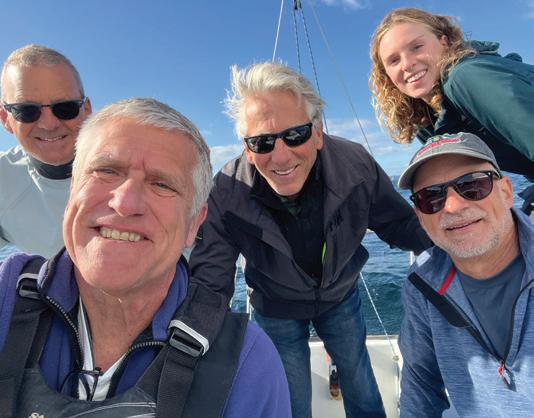
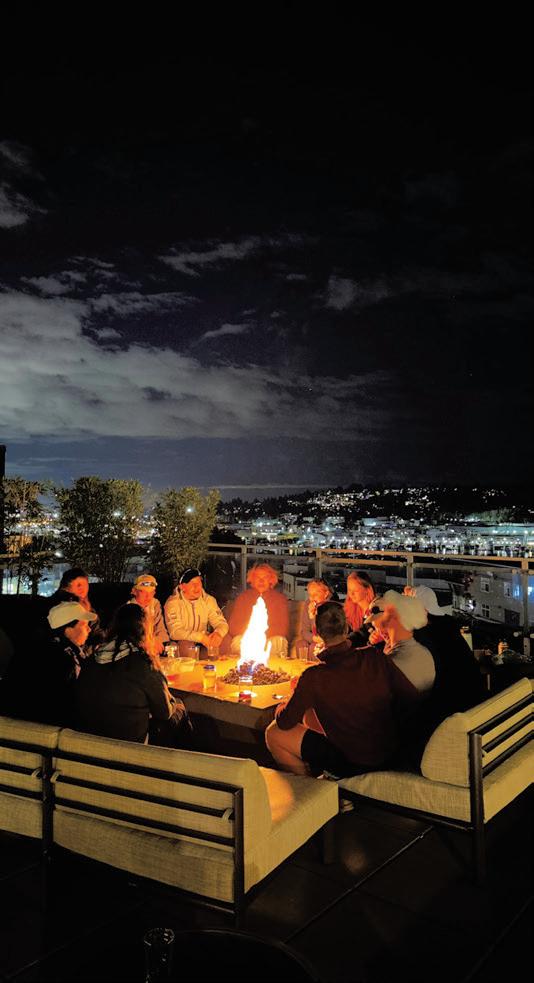
This new race management technology is rapidly being adopted around the world, growing almost as fast as the J/24 did after Rod Johnstone narrowly extracted Ragtime, the prototype J/24 from his 24-foot-long garage in 1977. During that first year, over 500 boats were delivered, and 200 more were pre-ordered.
This was my third J/24 World Championship experience, after Kingston, Ontario in 1989, and Annapolis, Maryland in 1992. Back then, in my twenties, I underappreciated how the new friends I was making would be the old friends I have now. Nothing could tell that story better than our crew on Self Abuse.
The age of a J/24 is given away by its sail number. Presumably Ragtime was clad in sail number 01. Seattle’s Harry Dursch bought sail number 2845 in 1981, christened her Self Abuse, and has been racing her ever since. At 43 years old, Harry’s Self Abuse is the longest continually owned and raced J/24 in Seattle, and maybe the world.
Harry said, “Buying Self Abuse back in 1981 led to lifelong friendships and travel to spectacular regatta venues I would never have visited otherwise. Our team for the 2024 Worlds was a great combination of old friends and new friends. Our team came together and focused on doing as well as we could. Now I’m looking forward to the next 43 years!”
Our team on Self Abuse could also have the highest combined age of any team at 279 years— including 18-year-old Esther Goodell. While it seems like it must be a typo, I asked Ryan Milne, skipper of one of the under 25 teams, for their combined age and he said 97. And if you think the additional 182 years we were hauling around the course gave us an advantage, just listen to the respect Ryan had for his team when he said: “The personalities on the boat all gelled together really easily. This summer was the most fun I’ve ever had with a team. One thing’s for sure, I’d sail with any of them any time.”
In addition to the new old friends she was making on Self Abuse, Esther was starting new young friendships that could go anywhere.
“One of my favorite parts was walking up and down the docks every morning. Each day the number of people I knew increased and so did the time it took me to walk to the bathroom. I ended the week with quite a few friends and plans to see each other again. I enjoyed getting to know the crew on my own boat, Self Abuse, and after racing I spent the evenings with the youth teams, stirring up trouble with kids from Colorado, Germany, New York, Portland, and Japan. I now have plans to snowboard with new friends in Colorado and see some Germans in Australia,” Esther said.
Over 5,600 J/24s have been built and are actively raced in 150 fleets in over 40 countries worldwide, making it easy to get a boat and to join the fun. Six years ago, Kurt Dammeier, CEO of Beecher’s Handmade Cheese, had never raced a sailboat when he looked out at the dozens of boats racing on Lake Washington on Tuesday nights. “I bought a J/24 online, with absolutely no idea what I was doing…worked really hard for six years and now here we are! We are proud to have the Seattle area show so well, and to have Beecher’s at the top of that, it warms my heart,” Kurt said.
Seattle’s sailors have traveled the world making friends
and winning world championships. One such traveler, Denny Vaughan, wanted to have the World Championships in Seattle. Regatta Chair Jon Anderson remembers how Denny got the idea started, “This was a great opportunity that Denny Vaughan, who is Vice President of the Class and local sailor on Easy Street, said ‘Let’s bring the Worlds to Seattle. It’s our turn to show the world what racing in Seattle is like and how Corinthian Yacht Club is such a great host club.’”
Two-time world champion Keith Whittemore was critical to the success of the event. Keith and his team had competed in 10 World Championships around the globe and had made friends along the way. “We have made a ton of very close friends in the J/24 community from all over the world. Being able to host them and entertain them in our lovely Seattle was a wonderful experience. We knew every boat that participated,” Keith said.
Brian Thomas, a member of Keith’s two winning Worlds teams, captured the spirit of friendship he has experienced in the J/24 class when he said, “I’ve always appreciated being able to race all around the world. What’s been the most surprising is the quality and duration of so many friendships created on and off the racecourse. Our hosting the J/24 Worlds here in Seattle was an opportunity to welcome everyone and connect once again. While our team did not compete, we were all here. Some racing and some, like Keith and me, observing, hosting, cheering, and smiling. Racing J/24s is the gift that keeps on giving.”
J/24s are easy to find, economical to race, and the fleets are full of welcoming new fiends. You can get one and travel the world racing in beautiful places. Winning the World
Kurt Dammeier and team sail downwind under the Beecher’s Handmade Cheese spinnaker. Photo by Dennis Pearce.
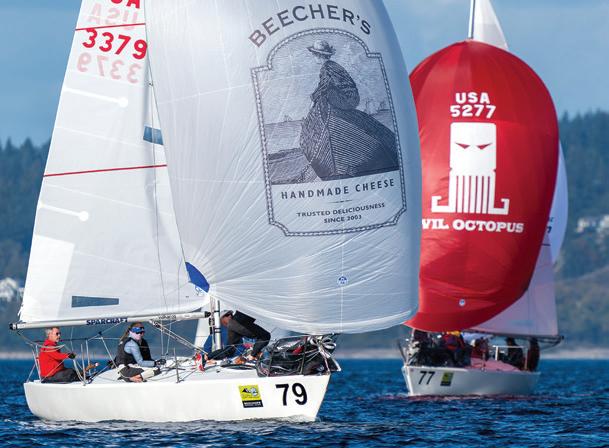
Championships may take a few tries, however, because the competition is formidable.
The next J/24 World Championships will be held from September 6 to 14, 2025 in Plymouth, England. To get involved in J/24 sailing in Seattle visit https://www.cycseattle.org/J/24. For full results, news articles, and video links about the regatta: https://www.j24worldsseattle.org
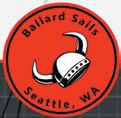





By Jonathan McKee
The final Red Ruby race for 2024 was the La Drheam-Cup / Grand Prix de France de Course au Large from Cherbourg to La Trinité-sur-Mer, France, in July.
This multiclass event typically features a 600-mile course for the doublehanders, but this year the course was shortened to 500 miles due to expected very light air at the finish. The entry list was arguably the most competitive doublehanded fleet of 2024, with nearly all the top U.K. boats and several top French doublehanders. The race was also the second leg of the IRC Double-Handed European Championship.
My partner for Drheam-Cup was British shorthanded expert, Will Harris. Will graduated from the Artemis Offshore Academy in 2011 and has been pursuing shorthanded racing ever since. He competed in the singlehanded Figaro circuit for many years, then signed on with Boris Herrmann’s Malizia IMOCA program in 2019, competing in The Ocean Race and several doublehanded IMOCA events with Boris as co-skipper.
At 30, Will has a great deal of recent shorthanded offshore experience and is intimately familiar with the coast of Brittany and the English Channel. While he had not sailed a Sunfast 3300, the boat is quite similar to the Figaro 3, which was his home for many years. I felt very lucky to have someone of Will’s knowledge and experience to learn from and as my partner for this race.
The start was a short Code Zero reach to a set mark, then a 10-mile close reach to Cap de la Hague to the north of Cherbourg. We had a great start to leeward of the fleet, until we were informed by VHF radio that we were over early, earning a one-hour penalty. Yikes! I thought we were clear, but I guess my judgment of the line is not what it used to be. In any case, we immediately had the challenge of an extra hour to make up, so we got to work.
A big dark cloud was approaching from the west as we neared Cap de la Hague and started the next leg across the English Channel to the Shambles. The wind quickly headed and built from 20 to 30 knots. We successfully dropped
the A2 spinnaker and trimmed the jib for the 70-mile reach across La Manche. We were going well and leading our class, with Chili Pepper just behind. At sundown, the breeze started to lift and we reset the Code Zero for the final miles to the Shambles.
Next, we turned upwind for a 200mile leg, all the way to Wolf Rock off the southwest tip of England. The course follows the coastal counties of Devon, Cornwall, and Dorset, with a series of bays and headlands that requires lots of tactical choices. The first night, we did not sail our best. I was having trouble keeping the boat going fast in the choppy conditions, and the wind shifted right a bit later than we expected, putting us on a bad shift for a time. When dawn arrived, we saw that our lead had evaporated. Our closest competitor was another Sunfast 3300 named Game On. They had gained 2 miles in the night, and a number of other boats were also close by. Time to get to work again!
Will had a clear plan of how we wanted to play the coastline, using the shifts at the headlands and setting up for the right
shift to come later that day. We also got a little bit of a break. The wind started dying, and we wanted to do a tack change from the J2 to the J1. When we got the new jib up and dropped the old, we noticed there was more wind if we carried on a port tack instead of tacking back to starboard. We only went for 10 minutes, but when we tacked back, we were to windward and lifting off the boats in our pack. We went from half a mile ahead to 4 miles in the next few hours.
All afternoon and evening, the wind held at 10 to 15 knots, but it was pretty shifty. We did our best to stay in phase and managed to round Wolf Rock with a modest lead in our class, and ahead of most of the fully crewed boats.
The next leg was south for 150 miles to a waypoint in the Atlantic. We initially worked our way left to take advantage of the expected southerly shift, but in the late evening the breeze died for a few hours. But as the southerly filled, we got it first, and again we extended our lead on the pack. Now there were only three boats in sight, but we could see a bunch more on AIS. All day we sailed upwind in moderate air, trying to make the boat go fast. At midnight we finally arrived at the Drheam waypoint, tacking onto starboard for the final leg to La Trinité-sur-Mer.
We were feeling pretty good about our position, over 6 miles ahead of the next boat and over 20 miles ahead of most of our fleet. However, there was a big highpressure zone between us and the finish 130 miles away. We elected to try to skirt the high to the north, and reached off below the rhumbline. Again, the wind got very light for several hours, barely enough to fill the spinnaker.
Finally, some new wind from the northwest started to fill. The boats behind got it first and made some gains, but we were still in a strong position. As we approached the coast of Brittany we got headed with more wind, so now we were running down the coast to the finish, 50 miles to the southwest. The wind held all night, but as morning dawned, the breeze was dying again and the current turned against us. The final miles were going to be hard.
There was one more big tactical decision before the finish—choosing which side of Belle-Île-en-Mer island to
A packed start gets off the line in Cherbourg.
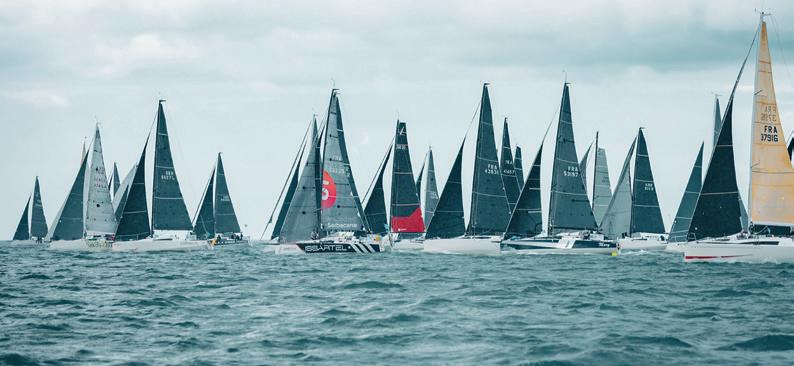
pass. We chose inshore, but in the end, offshore held more wind. We battled our way to the final turning mark. The French J/99 Axesail had been gaining on us all night in the moderate running, and the Sunfast 3600 Bellino had also brought new wind from behind, along with a few others. We were still ahead, but we owed both boats time, plus our one-hour penalty for the start. It was close, but we didn’t quite have enough of a lead. When the morning wind filled in Quiberon Bay, it was an easy fetch to the finish, so no more tactical options.
We crossed the line about 45 minutes ahead of Bellino and Axesail. They both beat us on handicap, but we stayed ahead of fourth place by 10 minutes, and our efforts were rewarded with a podium finish. It was bittersweet; we felt it was a race we could have won. On the other hand, we sailed really well, with some very
good tactical moves and no big mistakes except the start. We sailed hard and fast for four days. It was a really interesting and challenging course, always with decisions to make, and always ways to go faster.
Huge thanks to all the Red Ruby team, but especially to Will Harris for sailing with me on this race. He is an absolute master of all aspects of shorthanded ocean racing: weather, strategy, boat speed, energy management. I learned so much sailing with him. It was very cool to see what the state of the art really is.
In the end, Red Ruby won the IRC Double-Handed European Championship by virtue of our fifth-place finish in the Cowes Dinard Race, plus our third in Drheam-Cup. Thank you to all who have contributed to this effort over the last two years; you know who you are! It has been a great ride.
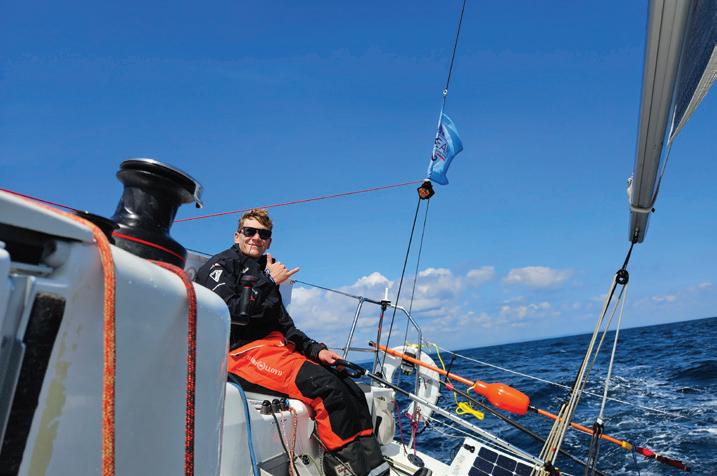
$12,500
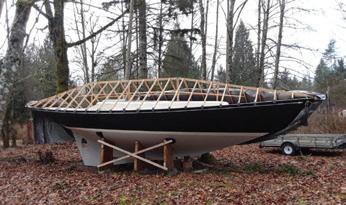
ANNAPOLIS 44
Annapolis 44 hull and deck for sale. Project build your own sailboat. Hull and deck are in great shape boat is located in Arlington WA. » Contact Blair Matthews at (360) 631-7749 or Grant at (360) 466-5152.
• bcmatt4@yahoo.com $12,500
$35,500

1983 BABA 30 - REDUCED PRICE
Designed by Robert Perry and built by TaShing. Cabin and topside painted with Awlgrip in 2015, new mast and standing rigging 2017. Repowered in 2001 with a Yanmar 3GM30 diesel. Dawn Treader has been well loved and well maintained, located on a private dock in Hansville, Washington.
» Contact Bruce Cosacchi • (206) 819-7079
• pbc200606@yahoo.com • $35,500
$16,000

25’ GAFF RIGGED CUTTER S/V TULLAMORE BUILT IN PORT TOWNSEND (1997)
One of three William Adkin designed cutters built at the Northwest School of Wooden Boat Building in Port Townsend during the late 1990s. She is 25’5” LOA, with a 7’10” beam and 3’10” draft. She carries four sails and easily sleeps three. She is powered by a 15hp Yanmar diesel with Raymarine ST2000+ auto pilot and Garmen Echomap DVwith GPS and depth indicator. Replacement cost in 6/20 was estimated at $150,000. For more information, request the 6/20 Survey.
» Contact Ross Mayberry • (206) 735-9592
• rossmayberry13@gmail.com • $16,000
$49,900
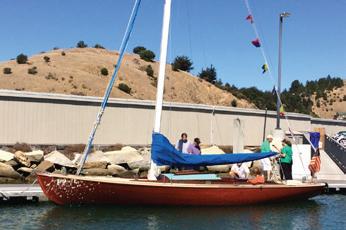
30’ YANKEE ONE SLOOP SAILBOAT
Master Mariner award winning, designed by William Starling Burgess/Stone built. Wooden hull. Roller furler. “Flame” totally restored in 2015. Complete survey in 2023 available. “A Sailor’s Sailboat”. Located in Richmond, CA.
» Contact Bob • stefroche916@gmail.com • $49,900
$30,000

22" CLASSIC DAYSAILER
Latitude 46 Tofinou 7 built in 1994. 22’ classic daysailer, with inboard diesel and varnished wood detailing, perfect for solo sailing or groups of 4. Furling jib, spinnaker, lazy jacks, tiller lock, retractable keel, with halyards and sheets accessible from the cockpit.
» Contact Bruce Bjerke • brucetbjerke@comcast.net
• $30,000
$145,000
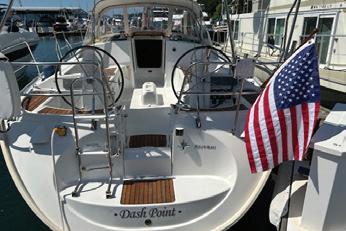
2003 JEANNEAU SUN ODYSSEY 40
Amazing performance cruiser for Salish Sea or offshore. Blue water vet: Mexico, Hawaii and Alaska. Excellent condition with all the gear: near new Yanmar 4JH57 (160 hrs) direct drive; aux fuel tank; MAX prop; water-maker; ESPAR hydronic heat; RADAR; AIS; power winch for main, Etc. Does it all with ease: single handed, with crew or family.
» Contact Dave Stromquist for full listing details
• (360) 606-9043 • dstromquist@comcast.net
• $145,000
$79,900
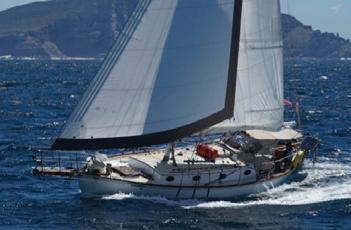
1977 ALAJUELA 38 MK 1
Upgrades (2019 – 2022) include engine (Beta 43), Navionics Suite, Solar, standing / running rigging, roller furling genoa, main and staysail. Monitor self steering, new max prop 4 blade, new electrical switchboard and cabling throughout. Completed 12 month circumnavigation 2022-2023. Ready for more. » Contact Douglas Wertz • (509) 438-1151
• dougwertz55@gmail.com • $79,900
$12,000

VANCOUVER 25' LRC FOR SALE
Full Keel – double ender with Yanmar diesel. Aft hung rudder. 25’ – 8’6” – 4’ Approximate 10,000 lbs. Forced air furnace – H/C water, refrigeration. Main – Jib + 150 roller furling. Hard dodger – enclosed cockpit. Auto pilot, two 28” x 48” flexible solar panels mounted on dodger roof. Self-steering vane (not mounted). Triple axel trailer included.
» Contact Vincent Smith • (360) 653-9130 • smith93331@comcast.net • $12,000
$40,000
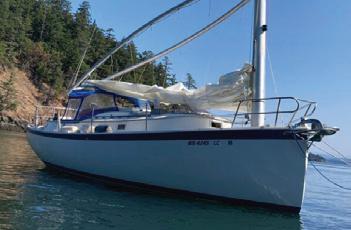
NONSUCH 30' ULTRA 1984
The Nonsuch 30’ Ultra has Hinterhoeller’s highest quality construction, superior handling and easy sailing with a free standing mast forward, running rigging controlled from the cockpit. 12’ beam with 6’3” headroom. New sail and running rigging, 1100 hours Westerbeke 27HP Many upgrades.
» Contact Peter Millington • (808) 557-0423 • millingtonpeter@yahoo.com
• $40,000
$72,900

CUSTOM 43’ EDSON SCHOCK KETCH (1973)
Professionally built of mahogany planking over oak frames, Debonair has been lovingly maintained. Extensive upgrades include new electrical and 75hp Yanmar. Consistently turning heads, Debonair is a seaworthy passage-maker, recently completing a 16,000nm tour of the South and North Pacific. From rig to sails, systems to safety, Debonair is voyage-ready. Details: porttownsendboatco.com or www.yachtworld.com/yacht/1973-custom-edsonschock-43'-ketch-8441971/ » Contact Vance Rucker • ketchdebonair@gmail.com • $72,900
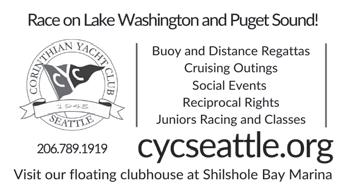




$600/mo
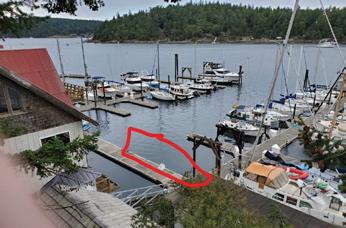
SAN JUAN ISLAND - FRIDAY HARBOR - 50' SLIP - MONTHLY RENTAL
Available immediately on San Juan Island (Friday Harbor). Great location, just 5 minute walk from ferry terminal in Friday Harbor. Long-term lease possibility. Photos available on request. First and Last month rent required. » Contact Mark Scheer • (206) 240-6978 • scheerlaw10@gmail.com • $600 per month

For even more photos and listings check out 48north.com/classifieds


No
When you are ready, give us a call. Professional service since 1967. CappyTom@aol.com • (206) 390- 1596




American Sailing Association courses Basic Keelboat 101 through Advanced Coastal 206 Based in Beautiful Anacortes, WA
sailtime.com/location/anacortes/sailing-school info@seattleyachts.com 206-351-8661 For even more photos and listings check out 48north.com/classifieds







(619) 224-2349 • Fax (619) 224-4692 • 2330 Shelter Island Dr. #207 San Diego, CA 92106 www.yachtfinders.biz • info@yachtfinders.biz
Sales on



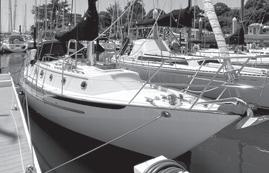
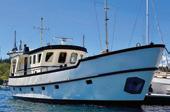
70’ SANTA CRUZ 70 ’87 ....................
$379,000
“WESTERLY” Completely updated with no expense spared.An excellent opportunity to obtain a very up-to-date SC 70 and get sailing now.
55’ ROBERTS 55 ’97
$169,000
....................
“KOOK” Proven to be strong enough for the most demanding conditions.She can undoubtedly take you to the anchorages of your choosing.
37’ PACIFIC SEACRAFT
PS37 ’87 .........
$179,000
“STELLA BLUE” Perfect ready-to-go cruiser. Beautiful condition. Fully equipped with the best of everything. One-year Santa Cruz slip possible.
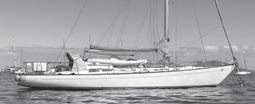
53’ SOUTHERN OCEAN GALLANT 53 ’70 $139,500 “AUNTIE” Beautiful lines and superb proportions. No crew needed. This one completed a solo circumnavigation.

46’ HUNTER 460 ’00 $129,500 “ALE ER RON” Versatile yacht for liveaboard, easy daysails or serious ocean passages. Reasonable offers considered.

43’ BENETEAU 42CC OCEANIS CLIPPER ’03 $119,000 “AEOLUS” Great classic cruiser for sea lovers! Feel at home everywhere in the functional and luscious interior.

39’ ERICSON 39 ’71 $79,500 “TRAVELER” Ideal performance cruiser for short-handed sailing. Meticulously upgraded. Nicely finished interior.

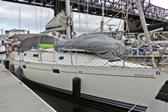




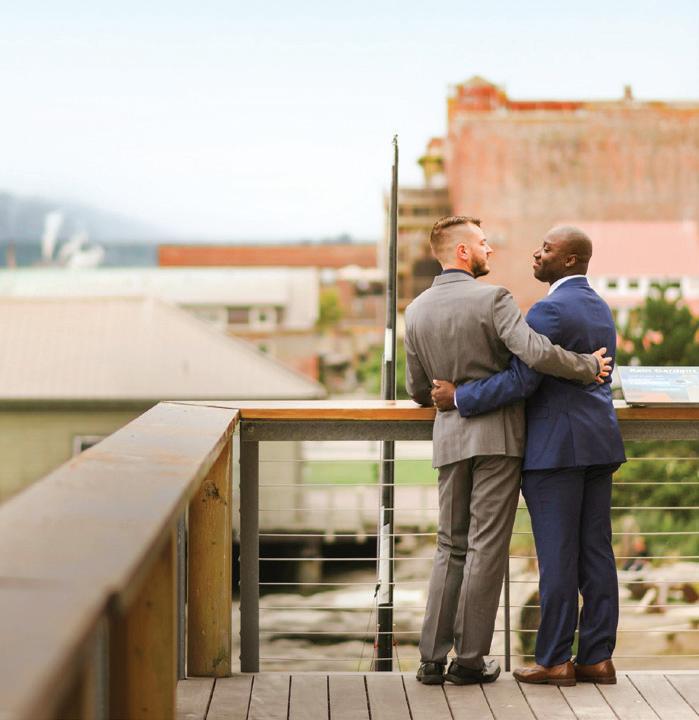


Experienced sailors know the added safety that comes with good sailing performance: the ability to sail off a lee shore, to fetch a safe harbor that is dead upwind or to complete a passage within an available weather window. The Outbound 46 Nomad speaks to each of these requirements while also delivering a comfortable environment whether offshore or in a far-off anchorage. Designed by renowned naval architect Carl Schumacher and built to the highest standards, Nomad will take you comfortably across any ocean. Her solid fiberglass construction offers the displacement required to give the yacht an easy and forgiving motion. Her lines and design define those characteristics: long waterline, moderate beam, high righting moment, proper weight distribution and efficient foils. Her semi-raised salon fills the cabin with natural light; handcrafted accommodations and superb load-carrying capability ensure your comfort whether you head out for an evening sail or a long offshore passage.


